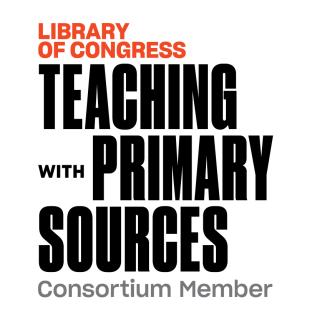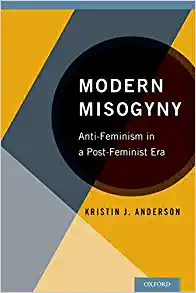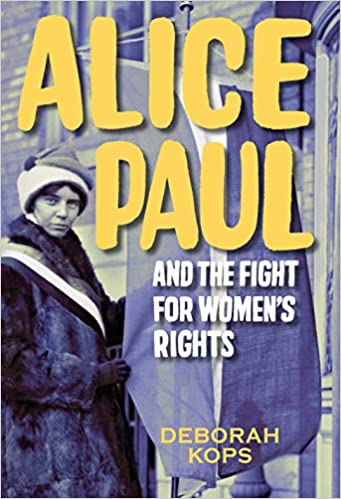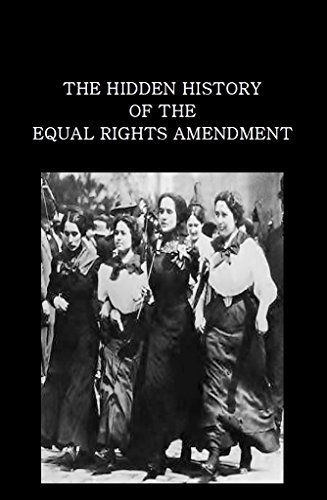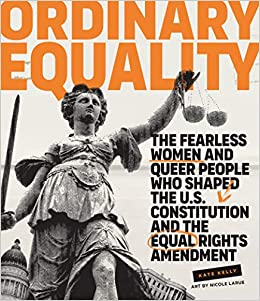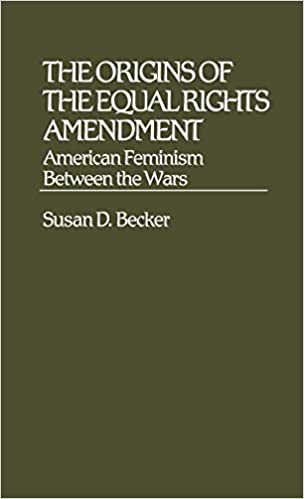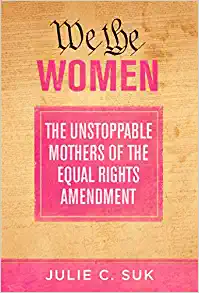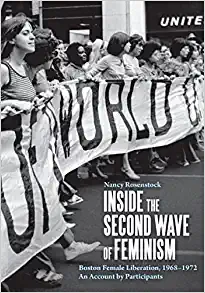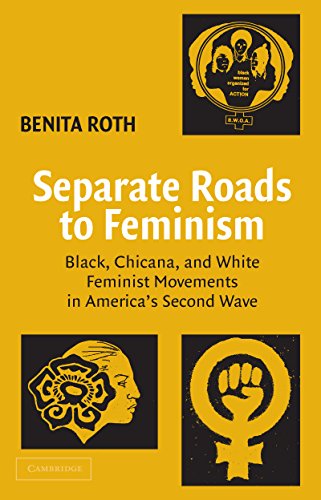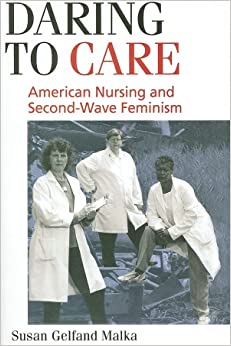24. The Feminist Era
|
Following the Civil Rights Movement, women were inspired to fight for equality and opportunity in society. As a result, many social movements arose in different communities which combatted sexism and sparked the rise of the women's liberation movement.
|
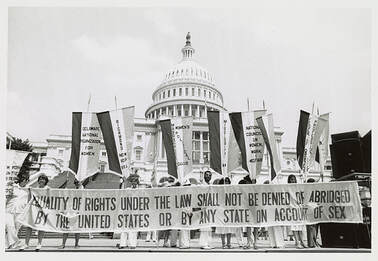 NOW outside of the White House, White House Archives
NOW outside of the White House, White House Archives
The Civil Rights Movement inspired other groups in America to speak up and fight for greater equality and opportunity in society. Social movements arose fighting for Native American, Gay, and Latino rights as well as an organized anti-war movement. Women involved in these various movements experienced sexism as they learned methods of political organizing, tactics to achieve goals, and the language needed to express their own frustrations. The 1960s witnessed the rise of the women’s liberation movement in which American women fought against their second class status in society.
During this time women achieved sweeping changes in law and society that dramatically altered social dynamics and improved women’s status. Major organizations like NOW were established, and a presidential commission on women was made to focus on the status of women around the country. As a result major legislation known as Title IX passed and the ERA, or Equal Rights Amendment, was proposed. It was a time of huge change.
During this time women achieved sweeping changes in law and society that dramatically altered social dynamics and improved women’s status. Major organizations like NOW were established, and a presidential commission on women was made to focus on the status of women around the country. As a result major legislation known as Title IX passed and the ERA, or Equal Rights Amendment, was proposed. It was a time of huge change.
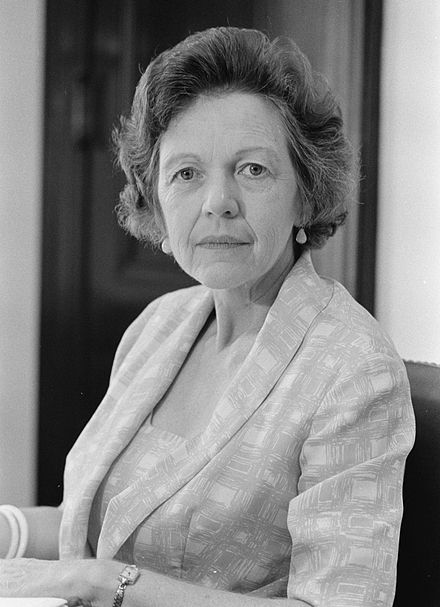 Maurine Neuberger-Solomon a Senator from Oregon 1962, Wikimedia Commons
Maurine Neuberger-Solomon a Senator from Oregon 1962, Wikimedia Commons
Frustrations Facing Women:
Women struggled against employment discrimination as they entered the workforce in greater numbers. In 1960, women made up only 6% of the nation’s doctors, 3% of its lawyers, and less than 1% of engineers, these figures are exponentially better today, but still small minorities. Over a million worked for the federal government but only made up just over 1% of the civil service workers in the top 4 pay scales. Women found themselves routinely passed over for positions that led to management training and executive responsibility. The earnings of women working full time jobs averaged only 60% of men working full time. State minimum wage requirements exempted most traditional women’s jobs. Help wanted advertisements were often separated into men’s and women’s postings.
In addition to employment struggles, many laws discriminated against women. Banks could refuse to issue a credit card to an unmarried woman, and if she was married, the card would be issued in her husband’s name. Banks often did not include a married woman’s earnings when calculating the family’s income for a loan application. In many states, women were excluded or exempted from serving on juries due to the belief it interfered with their primary responsibility as caregivers. Women’s nature was cited as additional reasoning, claiming women were too fragile to hear about grisly crimes or too sympathetic to remain objective. Birth control was restricted in many states and was only prescribed to married women for the purpose of family planning.
Elsewhere, in the STEM fields, while some women were breaking barriers in science, there was a clear acknowledgement that women were struggling to fully access these career options as well. In 1977, Rosalyn Yalow was the second woman to win a Nobel Prize when she won the Nobel Prize in Physiology or Medicine alongside her colleagues for the creation of radio-immunoassay, a technique to accurately and quickly measure a concentrations of hormones, vitamins, viruses, enzymes, drugs, and more. The next year Anna Jane Harrison was the first woman to be elected president of the American Chemical Society. However, women were still actively and passively discouraged from pursuing careers in science and technology. Jewel Plummer Cobb was a cell biologist and cancer researcher who, in 1979, wrote one of her most famous articles, “Filters for Women in Science,” which systematically broke down the barriers facing women entering the field.
Women lacked adequate representation in government. In 1962, there were only 2 women in the U.S. Senate and 18 women members of the House of Representatives.
Hattie Caraway and Margaret Chase Smith were the first women Senators, veterans of the position by 1962, but still their glass breaking did not clear the way for more women. Caraway of Arkansas became the first woman to win election to the Senate in 1932 and 1949 Margaret Chase Smith of Maine followed her, becoming the first woman to serve in both the U.S. House of Representatives and the Senate. Only 2 women had ever served in the President’s cabinet and only 6 had served as foreign ministers or ambassadors. No woman had served on the Supreme Court and only 2 women were federal district judges. Across the country there were over 7,000 elected state legislature positions and only 234 were held by women.
Women struggled against employment discrimination as they entered the workforce in greater numbers. In 1960, women made up only 6% of the nation’s doctors, 3% of its lawyers, and less than 1% of engineers, these figures are exponentially better today, but still small minorities. Over a million worked for the federal government but only made up just over 1% of the civil service workers in the top 4 pay scales. Women found themselves routinely passed over for positions that led to management training and executive responsibility. The earnings of women working full time jobs averaged only 60% of men working full time. State minimum wage requirements exempted most traditional women’s jobs. Help wanted advertisements were often separated into men’s and women’s postings.
In addition to employment struggles, many laws discriminated against women. Banks could refuse to issue a credit card to an unmarried woman, and if she was married, the card would be issued in her husband’s name. Banks often did not include a married woman’s earnings when calculating the family’s income for a loan application. In many states, women were excluded or exempted from serving on juries due to the belief it interfered with their primary responsibility as caregivers. Women’s nature was cited as additional reasoning, claiming women were too fragile to hear about grisly crimes or too sympathetic to remain objective. Birth control was restricted in many states and was only prescribed to married women for the purpose of family planning.
Elsewhere, in the STEM fields, while some women were breaking barriers in science, there was a clear acknowledgement that women were struggling to fully access these career options as well. In 1977, Rosalyn Yalow was the second woman to win a Nobel Prize when she won the Nobel Prize in Physiology or Medicine alongside her colleagues for the creation of radio-immunoassay, a technique to accurately and quickly measure a concentrations of hormones, vitamins, viruses, enzymes, drugs, and more. The next year Anna Jane Harrison was the first woman to be elected president of the American Chemical Society. However, women were still actively and passively discouraged from pursuing careers in science and technology. Jewel Plummer Cobb was a cell biologist and cancer researcher who, in 1979, wrote one of her most famous articles, “Filters for Women in Science,” which systematically broke down the barriers facing women entering the field.
Women lacked adequate representation in government. In 1962, there were only 2 women in the U.S. Senate and 18 women members of the House of Representatives.
Hattie Caraway and Margaret Chase Smith were the first women Senators, veterans of the position by 1962, but still their glass breaking did not clear the way for more women. Caraway of Arkansas became the first woman to win election to the Senate in 1932 and 1949 Margaret Chase Smith of Maine followed her, becoming the first woman to serve in both the U.S. House of Representatives and the Senate. Only 2 women had ever served in the President’s cabinet and only 6 had served as foreign ministers or ambassadors. No woman had served on the Supreme Court and only 2 women were federal district judges. Across the country there were over 7,000 elected state legislature positions and only 234 were held by women.
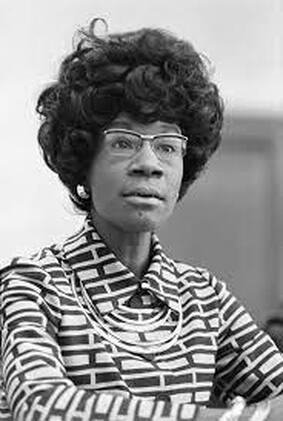 Shirley Chisholm, Courtesy of Barbara Wallace
Shirley Chisholm, Courtesy of Barbara Wallace
Race:
Feminism in this period did a better job than the suffrage era of being “intersectional,” a term used to describe the way a movement includes the needs of the diverse population within the movement. Feminism historically served middle-class white women more than other groups. As this new phase of feminism arrived, it was more inclusive, but still had a long way to go. The feminist movement was mainly led by middle-class white women. They focused on their own concerns, which caused a complicated and sometimes conflicting relationship with women from different social classes and races. Women of color in particular were pushed to the sidelines of the movement.
White feminists believed that gender was the main reason they faced exclusion from fully participating in American society. In contrast, Black women had to confront both racism and sexism, and they had to find ways to make Black men aware of gender issues while making white women aware of racial issues. Black feminists such as Michele Wallace, Mary Ann Weathers, bell hooks, Alice Walker, and Bettina Aptheker addressed these complex issues in their work and writing. In 1973, activists from the National Black Feminist Organization recognized that the aims of the feminist movement, including day care, abortion, maternity leave, and ending violence against women would benefit Black women and their families. Therefore, despite the frustrations, Black women and white women were able to build strong coalitions.
Feminism in this period did a better job than the suffrage era of being “intersectional,” a term used to describe the way a movement includes the needs of the diverse population within the movement. Feminism historically served middle-class white women more than other groups. As this new phase of feminism arrived, it was more inclusive, but still had a long way to go. The feminist movement was mainly led by middle-class white women. They focused on their own concerns, which caused a complicated and sometimes conflicting relationship with women from different social classes and races. Women of color in particular were pushed to the sidelines of the movement.
White feminists believed that gender was the main reason they faced exclusion from fully participating in American society. In contrast, Black women had to confront both racism and sexism, and they had to find ways to make Black men aware of gender issues while making white women aware of racial issues. Black feminists such as Michele Wallace, Mary Ann Weathers, bell hooks, Alice Walker, and Bettina Aptheker addressed these complex issues in their work and writing. In 1973, activists from the National Black Feminist Organization recognized that the aims of the feminist movement, including day care, abortion, maternity leave, and ending violence against women would benefit Black women and their families. Therefore, despite the frustrations, Black women and white women were able to build strong coalitions.
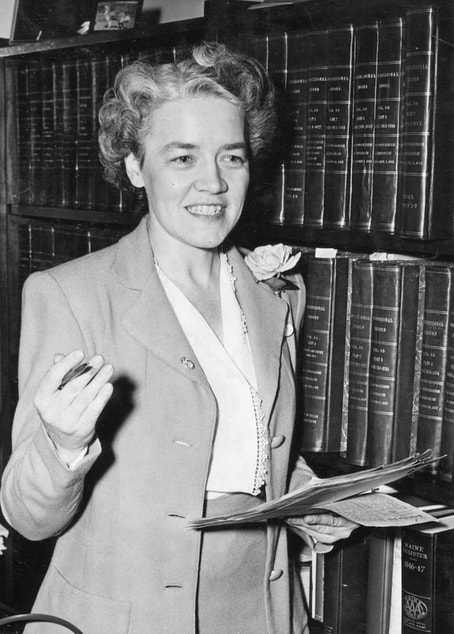 Senator Margaret Chase Smith, Getty Images
Senator Margaret Chase Smith, Getty Images
President’s Commission:
The women in leadership roles began pushing the government for action. In 1961, Esther Peterson, Assistant Secretary of Labor for Women's Affairs, suggested the creation of a President's Commission on the Status of Women. Established by President Kennedy by executive order, the bipartisan commission was chaired by Eleanor Roosevelt to examine discrimination against women and make recommendations on ways to eliminate it. The order stated “prejudices and outmoded customs act as barriers to the full realization of women's basic rights which should be respected and fostered as part of our Nation's commitment to human dignity, freedom, and democracy.” The commission found that women faced barriers that limited their opportunities for employment and advancement. It recommended that women be included for equal employment opportunity for federal contracts, advocated for changes to state laws that discriminated against women, and supported improvements such as affordable daycare and equal access to education for women. The creation of the President's Commission on the Status of Women led to similar commissions being established across the country. It helped to bring together women working for various women’s issues who had never met. They began discussing women’s rights, a topic not frequently discussed at the time. Together they created data that the women’s movement needed to challenge legislation at the federal and state level.
The early 1960s saw the passage of important federal legislation to help women. One direct result of the President's Commission on the Status of Women was the passage of the Equal Pay Act of 1963. It prohibits employers from paying unequal wages to men and women working jobs that “equal skill, effort, and responsibility, and which are performed under similar working conditions.” This was one of the first pieces of federal legislation to address gender discrimination. It was followed by the Civil Rights Act of 1964. While the legislation was a result of the hard work of the Civil Rights Movement and prohibited segregation in public places, it also banned employment discrimination on the basis of race, color, religion,or national origin. Representative Howard Smith (VA) proposed an amendment to include sex in the employment discrimination categories, a move that would likely kill the bill. Representative Martha Griffiths (MI) and the other female representatives lobbied in support of the amendment and it was included in the bill when it passed the House. Senator Margaret Chase Smith (ME) championed the bill in the Senate and the bill was signed into law by President Johnson in 1964. The law established the Equal Employment Opportunity Commission to help enforce the anti-discrimination provision of the law.
The women in leadership roles began pushing the government for action. In 1961, Esther Peterson, Assistant Secretary of Labor for Women's Affairs, suggested the creation of a President's Commission on the Status of Women. Established by President Kennedy by executive order, the bipartisan commission was chaired by Eleanor Roosevelt to examine discrimination against women and make recommendations on ways to eliminate it. The order stated “prejudices and outmoded customs act as barriers to the full realization of women's basic rights which should be respected and fostered as part of our Nation's commitment to human dignity, freedom, and democracy.” The commission found that women faced barriers that limited their opportunities for employment and advancement. It recommended that women be included for equal employment opportunity for federal contracts, advocated for changes to state laws that discriminated against women, and supported improvements such as affordable daycare and equal access to education for women. The creation of the President's Commission on the Status of Women led to similar commissions being established across the country. It helped to bring together women working for various women’s issues who had never met. They began discussing women’s rights, a topic not frequently discussed at the time. Together they created data that the women’s movement needed to challenge legislation at the federal and state level.
The early 1960s saw the passage of important federal legislation to help women. One direct result of the President's Commission on the Status of Women was the passage of the Equal Pay Act of 1963. It prohibits employers from paying unequal wages to men and women working jobs that “equal skill, effort, and responsibility, and which are performed under similar working conditions.” This was one of the first pieces of federal legislation to address gender discrimination. It was followed by the Civil Rights Act of 1964. While the legislation was a result of the hard work of the Civil Rights Movement and prohibited segregation in public places, it also banned employment discrimination on the basis of race, color, religion,or national origin. Representative Howard Smith (VA) proposed an amendment to include sex in the employment discrimination categories, a move that would likely kill the bill. Representative Martha Griffiths (MI) and the other female representatives lobbied in support of the amendment and it was included in the bill when it passed the House. Senator Margaret Chase Smith (ME) championed the bill in the Senate and the bill was signed into law by President Johnson in 1964. The law established the Equal Employment Opportunity Commission to help enforce the anti-discrimination provision of the law.
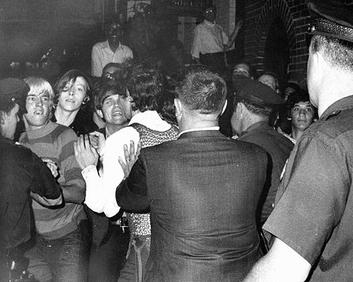 The Only Known Photo from the Night of the Stonewall Riots, Wikimedia Commons
The Only Known Photo from the Night of the Stonewall Riots, Wikimedia Commons
NOW:
In 1966 the Third National Conference of Commissions on the Status of Women was held with the theme “Targets for Action.” One issue of concern was the EEOC’s failure to enforce the prohibition on sex discrimination in employment. The EEOC refused to use its limited resources to act on women’s claims, feeling its main duty was to help African American workers. Attendees such as Betty Friedan and Pauli Murray became frustrated with the lack of action at the conference and wanted to make the theme a reality. Friedman invited a group of women to her hotel room and wrote NOW on a napkin, National Organization for Women. Together they created a new organization to fight for women’s rights with the purpose to “take action to bring women into full participation in the mainstream of American society now, exercising all the privileges and responsibilities thereof in truly equal partnership with men.” NOW pressured the EEOC to hold hearings about sex discrimination in employment ads and uphold its mandate to prohibit sex discrimination. NOW also lobbied the White House to expand affirmative action programs to include women and Congress to pass more legislation to benefit women.
The modern gay rights movement began in 1969 with the Stonewall Riots in New York and many of the activists in local NOW chapters were lesbians. They pushed the organization to fight for gay rights as well but encountered resistance and found themselves pushed out of leadership positions. Friedan referred to them as the “lavender menace” and worried their presence would destroy the credibility of the women’s movement and give the opposition ammunition against them. It was not until 1971 that NOW recognized lesbian rights as a concern for feminists.
In 1966 the Third National Conference of Commissions on the Status of Women was held with the theme “Targets for Action.” One issue of concern was the EEOC’s failure to enforce the prohibition on sex discrimination in employment. The EEOC refused to use its limited resources to act on women’s claims, feeling its main duty was to help African American workers. Attendees such as Betty Friedan and Pauli Murray became frustrated with the lack of action at the conference and wanted to make the theme a reality. Friedman invited a group of women to her hotel room and wrote NOW on a napkin, National Organization for Women. Together they created a new organization to fight for women’s rights with the purpose to “take action to bring women into full participation in the mainstream of American society now, exercising all the privileges and responsibilities thereof in truly equal partnership with men.” NOW pressured the EEOC to hold hearings about sex discrimination in employment ads and uphold its mandate to prohibit sex discrimination. NOW also lobbied the White House to expand affirmative action programs to include women and Congress to pass more legislation to benefit women.
The modern gay rights movement began in 1969 with the Stonewall Riots in New York and many of the activists in local NOW chapters were lesbians. They pushed the organization to fight for gay rights as well but encountered resistance and found themselves pushed out of leadership positions. Friedan referred to them as the “lavender menace” and worried their presence would destroy the credibility of the women’s movement and give the opposition ammunition against them. It was not until 1971 that NOW recognized lesbian rights as a concern for feminists.
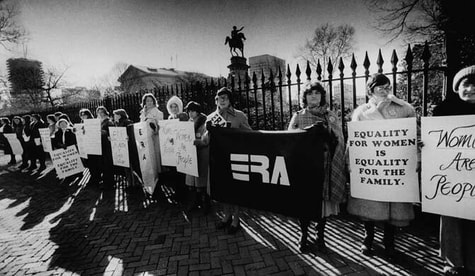 National Women’s Political Caucus, Gender on the Ballot
National Women’s Political Caucus, Gender on the Ballot
In addition to fighting for legislation, NOW and other women’s organizations, such as the ACLU Women’s Rights Project fought in the courts. Decided in 1971, the Supreme Court ruled for the first time in Reed v Reed that a law that discriminated against women was unconstitutional. This landmark case was followed by the decision in Roe v. Wade which allowed a woman the choice whether or not to terminate a pregnancy. The Supreme Court went on to invalidate state and federal laws differentiating between sexes, such as the sex-segregated help wanted ads. However, the Court failed to hold sex discrimination to the strict scrutiny standard it used for race. Laws distinguishing between races must be justified by a compelling legislative purpose while laws distinguishing between sex only had to have a reasonable relationship to the legislative purpose.
NOW also campaigned for women running for office. They supported the campaign of Shirley Chisholm who became the first Black woman elected to the House of Representatives. In 1971, Chisholm, along with other women leaders including Friedan, newly elected Representative Bella Abzug, and activist and Ms. Magazine founding editor, Gloria Steinem, founded the National Women’s Political Caucus. This organization is “dedicated exclusively to increasing women’s participation in all areas of political and public life.
NOW also campaigned for women running for office. They supported the campaign of Shirley Chisholm who became the first Black woman elected to the House of Representatives. In 1971, Chisholm, along with other women leaders including Friedan, newly elected Representative Bella Abzug, and activist and Ms. Magazine founding editor, Gloria Steinem, founded the National Women’s Political Caucus. This organization is “dedicated exclusively to increasing women’s participation in all areas of political and public life.
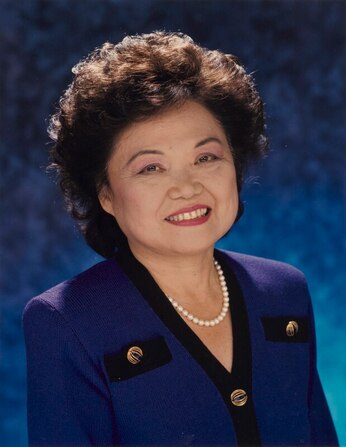 Patsy Mink, Wikimedia Commons
Patsy Mink, Wikimedia Commons
Title IX:
Women’s rights ran parallel to another important movement of the period, women’s equal access to educational opportunities, which obviously helped women’s rights tremendously. With equal access to education, women were more empowered, and therefore women sought more leadership roles.
Patsy Mink, an Asian-American member of the U.S. House of Representatives, co-authored and sponsored the Title IX legislation, officially known as the Education Amendments of 1972. Title IX prevented discrimination on the basis of sex in schools receiving public funding. This legislation was interpreted to protect girls from sexual harassment and discrimination. It ensured that if an opportunity existed for boys, it could exist for girls too.
Mink was a strong advocate for gender equality and worked tirelessly to eliminate gender-based discrimination in education. Patsy Mink's personal experiences and her commitment to equal opportunity for women in education fueled her dedication to this cause.
Women’s rights ran parallel to another important movement of the period, women’s equal access to educational opportunities, which obviously helped women’s rights tremendously. With equal access to education, women were more empowered, and therefore women sought more leadership roles.
Patsy Mink, an Asian-American member of the U.S. House of Representatives, co-authored and sponsored the Title IX legislation, officially known as the Education Amendments of 1972. Title IX prevented discrimination on the basis of sex in schools receiving public funding. This legislation was interpreted to protect girls from sexual harassment and discrimination. It ensured that if an opportunity existed for boys, it could exist for girls too.
Mink was a strong advocate for gender equality and worked tirelessly to eliminate gender-based discrimination in education. Patsy Mink's personal experiences and her commitment to equal opportunity for women in education fueled her dedication to this cause.
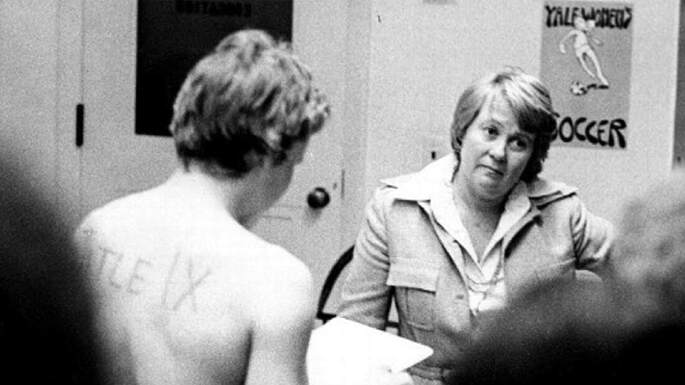 Yale Student Protesting
Yale Student Protesting
Title IX, in its early years, had the largest impact on girls and women’s sports in high school and college, which were often an afterthought. Girls teams were often given the boys hand-me-downs and received little, if any funding. In one case, a girls basketball game was canceled mid game so the boys team could practice. To add insult to injury, at the University of Michigan, dogs were allowed in the stadium, but not girls sports fans, so the notion that girls might one day be the featured athletic talent was a distant dream.
Title IX required schools treat boys and girls equally: so sports teams needed to be funded equally. If the boys soccer team got X dollars, the girls team should get X dollars. This of course meant major changes in how schools budgeted for their sports teams and the mostly male coaches and administrators were not thrilled. Battles over Title IX erupted in schools and courts around the country.
In 1976, 19 college athletes from Yale protested the unfair treatment of women in sports. The women's rowing team faced inequalities and lacked facilities, including locker rooms, bathrooms, and an equipment manager. The athletes stripped their uniforms to reveal "Title IX" written on their bodies, drawing attention to the landmark legislation. They wanted to address the violations of Title IX, as the university neglected their needs while providing better facilities for male athletes. The protest highlighted gender disparities and demanded equal treatment for women in sports.
Title IX required schools treat boys and girls equally: so sports teams needed to be funded equally. If the boys soccer team got X dollars, the girls team should get X dollars. This of course meant major changes in how schools budgeted for their sports teams and the mostly male coaches and administrators were not thrilled. Battles over Title IX erupted in schools and courts around the country.
In 1976, 19 college athletes from Yale protested the unfair treatment of women in sports. The women's rowing team faced inequalities and lacked facilities, including locker rooms, bathrooms, and an equipment manager. The athletes stripped their uniforms to reveal "Title IX" written on their bodies, drawing attention to the landmark legislation. They wanted to address the violations of Title IX, as the university neglected their needs while providing better facilities for male athletes. The protest highlighted gender disparities and demanded equal treatment for women in sports.
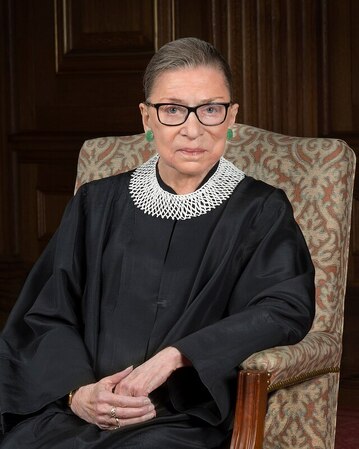 Ruth Bader Ginsburg, Wikimedia Commons
Ruth Bader Ginsburg, Wikimedia Commons
As a result of Title IX, women and girls gained greater access to athletic scholarships, improved facilities, and increased participation in sports, fostering personal growth, health, and empowerment.
But while Title IX made headlines for sports, probably the most significant impact was curbing discrimination that had long term impacts on women’s future careers and lives. In schools girls had been segregated into classes that taught them the skills of a housekeeper, while boys learned the skills of a trade or prepared them for college academics. Girls who took those courses were often the only ones in the room and faced harassment from the teachers and students alike.
A famous example was when women began entering Harvard law school in the late 1950s, a professor looked out at the freshman class and made all the women stand and explain why they were taking a spot from a man. Ruth Bader Ginsburg, a future Supreme Court Justice, was in one of those classes and ended up leaving Harvard for Columbia, which she felt treated women better.
But while Title IX made headlines for sports, probably the most significant impact was curbing discrimination that had long term impacts on women’s future careers and lives. In schools girls had been segregated into classes that taught them the skills of a housekeeper, while boys learned the skills of a trade or prepared them for college academics. Girls who took those courses were often the only ones in the room and faced harassment from the teachers and students alike.
A famous example was when women began entering Harvard law school in the late 1950s, a professor looked out at the freshman class and made all the women stand and explain why they were taking a spot from a man. Ruth Bader Ginsburg, a future Supreme Court Justice, was in one of those classes and ended up leaving Harvard for Columbia, which she felt treated women better.
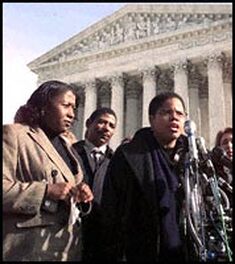 Verna Williams Attorney for LaShonda Davis, Washington Post
Verna Williams Attorney for LaShonda Davis, Washington Post
Several supreme court cases protected students from harassment by their peers and teachers. In the 1999 case, Davis v. Monroe County Board of Education, the Supreme Court clarified the rules for holding schools responsible for student-on-student sexual harassment under Title IX. The case involved a fifth-grade student named LaShonda Davis, who was sexually harassed by another student. Despite LaShonda's complaints, the school did not take action. LaShonda's parents sued the school board, claiming that the school had violated Title IX.
The Supreme Court decided that a school district can be held responsible for student-on-student sexual harassment if they knew about it and did nothing, and if the harassment was severe, widespread, and created an unfriendly environment that affected the victim's education. This ruling stated that schools must address and prevent sexual harassment between students to ensure a safe learning environment.
The Supreme Court decided that a school district can be held responsible for student-on-student sexual harassment if they knew about it and did nothing, and if the harassment was severe, widespread, and created an unfriendly environment that affected the victim's education. This ruling stated that schools must address and prevent sexual harassment between students to ensure a safe learning environment.
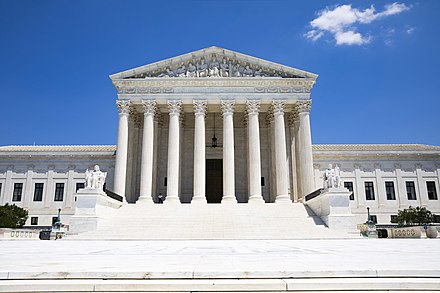 The Supreme Court House, Wikimedia Commons
The Supreme Court House, Wikimedia Commons
Another one protected students from teacher harassment. In Gebser v. Lago Vista Independent School District the Supreme Court dealt with the issue of liability for sexual harassment by a school employee under Title IX. Alida Star Gebser, a student, had a sexual relationship with a teacher at Lago Vista High School. Gebser and her mother sued the school district, claiming that the school knew about the teacher's misconduct but did not take appropriate action. The Supreme Court decided that a school district can be held responsible for sexual harassment by a teacher under Title IX if they had actual knowledge of the harassment and ignored it. So basically, the government over and over held that schools should be free from harassment so that kids can go there to learn.
Title IX gave women a chance at equal opportunities in school. Girls learned how to be leaders through their engagement in sports and over the next several decades not only matched men in college graduation rates, but surpassed them (a concern for the status of boys in academic achievement is valid and important). But did that equality extend beyond school? What happened when girls entered the world?
Title IX gave women a chance at equal opportunities in school. Girls learned how to be leaders through their engagement in sports and over the next several decades not only matched men in college graduation rates, but surpassed them (a concern for the status of boys in academic achievement is valid and important). But did that equality extend beyond school? What happened when girls entered the world?
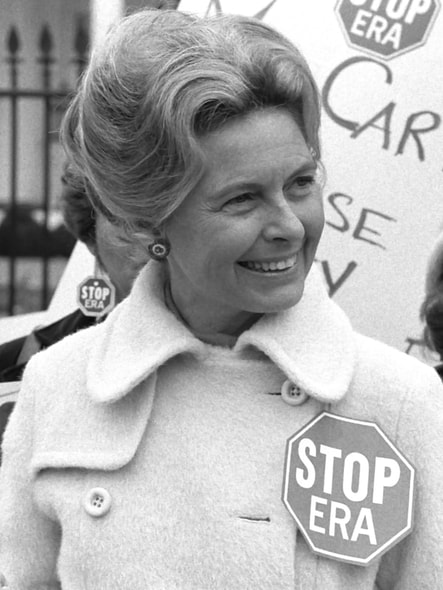 Phyllis Schlafly, Wikimedia Commons
Phyllis Schlafly, Wikimedia Commons
ERA:
Outside of the classroom, women fought for labor protections, childcare, maternity leave, and greater representation in all fields, especially government. Decades before, in 1923 Alice Paul and the National Women’s Party proposed the ERA. The ERA was intended to remove all legal barriers to women’s equality. The NWP believed the amendment would cost less than state by state legislative challenges and bring permanent equality to women in the country by enshrining the concept in the Constitution. The ERA was introduced in every session of Congress but failed to make it out of committee. In the 1940s both the Republican and Democratic party endorsed the ERA in their platforms. Despite the support, the ERA failed to move forward with many women’s organizations in opposition due to the belief that it would invalidate protective labor laws they fought for during the Progressive era for women.
By the 1970s, ERA supporters convinced Senator Birch Bayh (IN) to hold Congressional hearings on the amendment in the Senate and Representative Martha Griffiths filed a motion to discharge the ERA from the House Judiciary Committee. During debate over the amendment, women presented evidence as to the necessity of a Constitutional amendment. They claimed sex discrimination was still more the rule than the exception in America. For example, in some states height requirements for police forces were set to exclude women and in other states public assistance programs provided less food for women claiming they needed less to survive. Congress found that college admissions discriminated against women. Finally in 1972, almost 50 years after it was first introduced, Congress passed the Equal Rights Amendment reading “Equality of rights under the law shall not be denied or abridged by the United States or by any state on account of sex.” According to the Constitution, a proposed amendment must be ratified by three-fourth of the states. Congress set a seven year deadline for ratification of the ERA.
Within the first year, twenty-two states approved the ERA and eight more ratified in 1973. Supporters believed the amendment would quickly become a part of the U.S. Constitution. However, they underestimated the opposition and failed to develop a strategy to successfully combat their arguments. The leader of the opposition was a conservative from Illinois, Phyllis Schlafly. She used her nationwide newsletter to campaign against the ERA and create an opposition organization, STOP ERA, meaning Stop Taking Our Privileges. She and members of the organization traveled to states to testify against the ERA.
Outside of the classroom, women fought for labor protections, childcare, maternity leave, and greater representation in all fields, especially government. Decades before, in 1923 Alice Paul and the National Women’s Party proposed the ERA. The ERA was intended to remove all legal barriers to women’s equality. The NWP believed the amendment would cost less than state by state legislative challenges and bring permanent equality to women in the country by enshrining the concept in the Constitution. The ERA was introduced in every session of Congress but failed to make it out of committee. In the 1940s both the Republican and Democratic party endorsed the ERA in their platforms. Despite the support, the ERA failed to move forward with many women’s organizations in opposition due to the belief that it would invalidate protective labor laws they fought for during the Progressive era for women.
By the 1970s, ERA supporters convinced Senator Birch Bayh (IN) to hold Congressional hearings on the amendment in the Senate and Representative Martha Griffiths filed a motion to discharge the ERA from the House Judiciary Committee. During debate over the amendment, women presented evidence as to the necessity of a Constitutional amendment. They claimed sex discrimination was still more the rule than the exception in America. For example, in some states height requirements for police forces were set to exclude women and in other states public assistance programs provided less food for women claiming they needed less to survive. Congress found that college admissions discriminated against women. Finally in 1972, almost 50 years after it was first introduced, Congress passed the Equal Rights Amendment reading “Equality of rights under the law shall not be denied or abridged by the United States or by any state on account of sex.” According to the Constitution, a proposed amendment must be ratified by three-fourth of the states. Congress set a seven year deadline for ratification of the ERA.
Within the first year, twenty-two states approved the ERA and eight more ratified in 1973. Supporters believed the amendment would quickly become a part of the U.S. Constitution. However, they underestimated the opposition and failed to develop a strategy to successfully combat their arguments. The leader of the opposition was a conservative from Illinois, Phyllis Schlafly. She used her nationwide newsletter to campaign against the ERA and create an opposition organization, STOP ERA, meaning Stop Taking Our Privileges. She and members of the organization traveled to states to testify against the ERA.
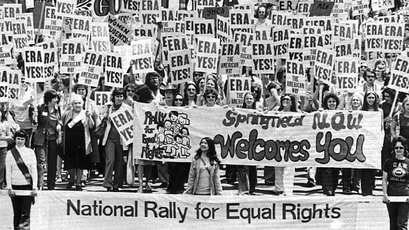 ERA Rally, NPR
ERA Rally, NPR
Opponents contended the amendment was unnecessary because women’s rights were already protected. They pointed to the equal protection clause of the Fourteenth amendment, the Civil Rights Act of 1964 and the variety of recent legislation as evidence. Opponents argued that women could use the existing laws to challenge discrimination in the courts.
The opposition focused much of the debate on how the ERA would erode traditional family values and have negative unintended consequences. Schlafly said that trying to achieve women’s goals through the ERA was “like trying to kill a fly with a sledgehammer. You won’t kill the fly, but you surely will break up some of the furniture.” Opponents argued that women had special privileges due to their gender that the ERA would eliminate. They claimed the ERA would require women to contribute equally to the family’s income. Therefore, they claimed the amendment would force women into the workforce and take away her choice to be a homemaker. Opponents also contended that ERA would erode states’ rights and destroy the traditional family structure in America. It would take issues related to the sexes and the family out of state control. The amendment would invalidate state laws related to such things as divorce, child custody, alimony and inheritance.
The ERA, opponents maintained, would have broader impacts on society as well. Women would be drafted and sent into combat where they would have to perform tasks they were not able to handle. Opponents argued this would be dangerous for the country. They also claimed the ERA would lead to sexual sameness and lead to unisex restrooms and an end to gender specific organizations like the Boy Scouts. Opponents also asserted the ERA would allow homosexuality in society and legalize same sex marriages since it would not allow any distinctions based on sex. The amendment, according to opponents, would lead to societal chaos.
The opposition focused much of the debate on how the ERA would erode traditional family values and have negative unintended consequences. Schlafly said that trying to achieve women’s goals through the ERA was “like trying to kill a fly with a sledgehammer. You won’t kill the fly, but you surely will break up some of the furniture.” Opponents argued that women had special privileges due to their gender that the ERA would eliminate. They claimed the ERA would require women to contribute equally to the family’s income. Therefore, they claimed the amendment would force women into the workforce and take away her choice to be a homemaker. Opponents also contended that ERA would erode states’ rights and destroy the traditional family structure in America. It would take issues related to the sexes and the family out of state control. The amendment would invalidate state laws related to such things as divorce, child custody, alimony and inheritance.
The ERA, opponents maintained, would have broader impacts on society as well. Women would be drafted and sent into combat where they would have to perform tasks they were not able to handle. Opponents argued this would be dangerous for the country. They also claimed the ERA would lead to sexual sameness and lead to unisex restrooms and an end to gender specific organizations like the Boy Scouts. Opponents also asserted the ERA would allow homosexuality in society and legalize same sex marriages since it would not allow any distinctions based on sex. The amendment, according to opponents, would lead to societal chaos.
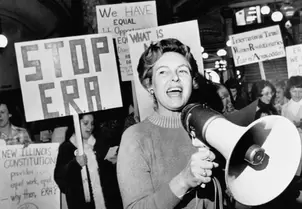 TIME
TIME
Proponents of the ERA found themselves on the defensive and were forced to confront their opponents’ concerns. The opponents successfully shifted much of the debate on the ERA away from the constitutional principles to the claim that the amendment would create radical change to American society. Supporters continued to demonstrate the need for the amendment as well as refute opponents’ claims.
The Fourteenth amendment was not adequate protection for women, supporters declared. They pointed to the many instances of discrimination against women since the Fourteenth amendment’s passage. For example, if the due process and equal protection clauses found in the Fourteenth truly protected women’s rights, then the Nineteenth amendment, guaranteeing women the right to vote, would not have been necessary. Federal legislation, supporters pointed out, were full of loopholes, subject to change, and not comprehensive. Proponents also said that courts routinely did not interpret the Fourteenth amendment in ways that truly protected women. Fighting discrimination on a case by case basis was expensive and time consuming. The ERA was needed to enshrine women’s rights fully into the Constitution and end continued discriminatory practices found across the country. Passage of ERA would send a clear message that the nation was committed to its core value, equality for all.
Constitutional and legal scholars concluded the ERA would not hurt states’ rights and that the amendment did not prevent legislation that makes distinctions between physical characteristics. While supporters conceded the ERA would make women eligible for the draft, they argued this was a positive consequence since it would increase opportunities for women in the armed services. Current restrictions based on sex hurt a woman’s chance of reaching the rank of general and the ERA would open jobs such as pilots, navigators, and flight engineers which were closed to women. Supporters said if women expected the same rights as men, they must be willing to take on the responsibility of defending the country.
The Fourteenth amendment was not adequate protection for women, supporters declared. They pointed to the many instances of discrimination against women since the Fourteenth amendment’s passage. For example, if the due process and equal protection clauses found in the Fourteenth truly protected women’s rights, then the Nineteenth amendment, guaranteeing women the right to vote, would not have been necessary. Federal legislation, supporters pointed out, were full of loopholes, subject to change, and not comprehensive. Proponents also said that courts routinely did not interpret the Fourteenth amendment in ways that truly protected women. Fighting discrimination on a case by case basis was expensive and time consuming. The ERA was needed to enshrine women’s rights fully into the Constitution and end continued discriminatory practices found across the country. Passage of ERA would send a clear message that the nation was committed to its core value, equality for all.
Constitutional and legal scholars concluded the ERA would not hurt states’ rights and that the amendment did not prevent legislation that makes distinctions between physical characteristics. While supporters conceded the ERA would make women eligible for the draft, they argued this was a positive consequence since it would increase opportunities for women in the armed services. Current restrictions based on sex hurt a woman’s chance of reaching the rank of general and the ERA would open jobs such as pilots, navigators, and flight engineers which were closed to women. Supporters said if women expected the same rights as men, they must be willing to take on the responsibility of defending the country.
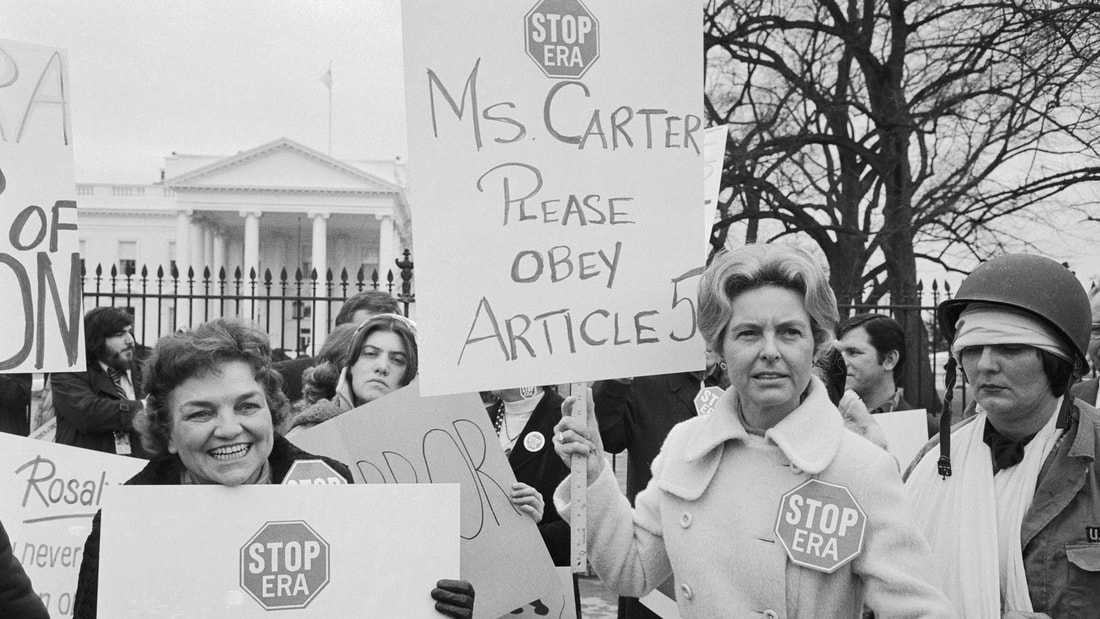 New York Times
New York Times
Supporters asserted the amendment would not radically change the American family structure. They said the protection of women as wives and mothers depended on mutual affection between men and women and not the law. The ERA, proponents argued, would not force women into the workforce but actually help recognize the contributions made by women in the home.
By 1977, only thirty five states had ratified the ERA, leaving it three states short of the necessary three-fourths to become a part of the Constitution. The original congressional deadline was set to expire in March 1979. Arguing that the ERA was still being actively debated in the states, Congress granted a three year extension until 1982. As long as there were vocal opponents to the ERA, especially large groups of women, state legislators felt confident in voting against it. Therefore, despite the extension, the Equal Rights Amendment fell three states short of the thirty-eight states needed to become a part of the U.S. Constitution.
Opponents of the amendment celebrated while proponents attempted to regroup and devise a new plan of action. NOW promised to work toward defeating anti-ERA legislators across the country. The fight for the ERA had held together the women’s movement for a long time. With its defeat, the women’s liberation movement lost momentum and gradually declined. Groups fragmented while continuing to fight for various women’s issues.
By 1977, only thirty five states had ratified the ERA, leaving it three states short of the necessary three-fourths to become a part of the Constitution. The original congressional deadline was set to expire in March 1979. Arguing that the ERA was still being actively debated in the states, Congress granted a three year extension until 1982. As long as there were vocal opponents to the ERA, especially large groups of women, state legislators felt confident in voting against it. Therefore, despite the extension, the Equal Rights Amendment fell three states short of the thirty-eight states needed to become a part of the U.S. Constitution.
Opponents of the amendment celebrated while proponents attempted to regroup and devise a new plan of action. NOW promised to work toward defeating anti-ERA legislators across the country. The fight for the ERA had held together the women’s movement for a long time. With its defeat, the women’s liberation movement lost momentum and gradually declined. Groups fragmented while continuing to fight for various women’s issues.
Conclusion:
Title IX has transformed women’s lives, school campuses, and empowered women. Title IX's comprehensive approach to combating gender-based discrimination, promoting equal opportunities, and fostering inclusivity has had a profound and lasting impact on women's lives. It has not only expanded educational and athletic opportunities but also challenged societal norms and advanced the pursuit of gender equality, making it widely recognized as a landmark legislation of the 20th century.
The ERA continues to be introduced in Congress still today. Illinois, Nevada, and Virginia all ratified the amendment in recent years. Some claim the time limit placed on the ratification was unconstitutional since the Article V of the Constitution which describes the amendment process does not include language about time limits. By this argument, with these three states, the ERA should become part of the Constitution. Others, including a recent court decision, say that the amendment is dead and in order to become a part of the Constitution, the process must start again. The ERA would have to be voted on by Congress and then sent to the states again for ratification.
Despite the failure of the ERA, the fight for it helped to politicize women across the country. Women, on both sides of the issue, wrote letters, visited legislators, and protested in support of their cause. They learned how to lobby for important issues and the importance of electing supportive officials. Women took on a much more active role in politics due to the fight for the Equal Rights Amendment.
By the end of this era, so much remained in question. Would the ERA ever pass? Was it good for women? What would be the lasting effects of the feminist movement?
Title IX has transformed women’s lives, school campuses, and empowered women. Title IX's comprehensive approach to combating gender-based discrimination, promoting equal opportunities, and fostering inclusivity has had a profound and lasting impact on women's lives. It has not only expanded educational and athletic opportunities but also challenged societal norms and advanced the pursuit of gender equality, making it widely recognized as a landmark legislation of the 20th century.
The ERA continues to be introduced in Congress still today. Illinois, Nevada, and Virginia all ratified the amendment in recent years. Some claim the time limit placed on the ratification was unconstitutional since the Article V of the Constitution which describes the amendment process does not include language about time limits. By this argument, with these three states, the ERA should become part of the Constitution. Others, including a recent court decision, say that the amendment is dead and in order to become a part of the Constitution, the process must start again. The ERA would have to be voted on by Congress and then sent to the states again for ratification.
Despite the failure of the ERA, the fight for it helped to politicize women across the country. Women, on both sides of the issue, wrote letters, visited legislators, and protested in support of their cause. They learned how to lobby for important issues and the importance of electing supportive officials. Women took on a much more active role in politics due to the fight for the Equal Rights Amendment.
By the end of this era, so much remained in question. Would the ERA ever pass? Was it good for women? What would be the lasting effects of the feminist movement?
Draw your own conclusions
|
Learn how to teach with inquiry.
Many of these lesson plans were sponsored in part by the Library of Congress Teaching with Primary Sources Eastern Region Program, coordinated by Waynesburg University, the History and Social Studies Education Faculty at Plymouth State University, and the Patrons of the Remedial Herstory Project. |
Lesson Plans from Other Organizations
- The National Women's History Museum has lesson plans on women's history.
- The Guilder Lehrman Institute for American History has lesson plans on women's history.
- The NY Historical Society has articles and classroom activities for teaching women's history.
- Unladylike 2020, in partnership with PBS, has primary sources to explore with students and outstanding videos on women from the Progressive era.
- The Roy Rosenzweig Center for History and New Media has produced recommendations for teaching women's history with primary sources and provided a collection of sources for world history. Check them out!
- The Stanford History Education Group has a number of lesson plans about women in US History.
Period Specific Lesson Plans from Other Organizations
- Feminism:
- Clio: This lesson plan introduces students to feminism, which is both a historical movement and a political ideology. Its focus is on American feminist activists since 1945. Students have the opportunity to explore various definitions of feminism and to research individual feminist activists. The exercises from this class session can be integrated into lessons investigating the development of democracy, the histories of movements for social justice and equal rights, and social changes since World War II.
- Clio: This lesson introduces students to women activists who helped define and broaden the public discussion of women’s issues in the late 1960s, an era of enormous political upheaval in the United States and around the world.
- Clio: This lesson introduces students to the pioneering woman politician Senator Margaret Chase Smith, who sought to become the first woman President of the United States in 1964. She and other women in the U.S. Congress served as ambassadors for expanding women’s roles in American society in the 1960s and 1970s.
- Clio: In the early 1970s, Boston feminists established a collective to teach themselves and other women about their bodies. Their path-breaking book Our Bodies, Ourselves is now published in 30 languages. In the same era, the Supreme Court ruling Roe v. Wade guaranteed a woman’s right to have an abortion. In the early 1990s, Black women health activists began organizing around the concept of Reproductive Justice, which connects reproductive rights and social justice. Reproductive Justice is defined “as the human right to maintain personal bodily autonomy, have children, not have children, and parent the children we have in safe and sustainable communities.”
- Equal Rights Amendment:
- Stanford History Education Group: In this lesson, students are presented with a claim made on Twitter about the popularity of the Equal Rights Amendment in the 1970s. Students use the internet to evaluate the trustworthiness of the claim and to determine whether the Equal Rights Amendment had popular support in the 1970s and whether it does today.
- PBS: This inquiry kit features Library of Congress sources examining support for and against the Equal Rights Amendment (ERA). What was the Equal Rights Amendment? Why were people against the ERA? Which parts of the ERA do you think were successful and which parts still need work?
- Voices of Democracy: Students examine a Gloria Steinem’s testimony in Congress defending the ERA. What evidence does Steinem offer to support her claims? Did you find her arguments convincing?
- Voices of Democracy: This speech relates “Women’s Liberation” to social changes that occurred during the 1960s and 1970s, such as the anti-war and civil rights movements. Steinem’s address helps students see the connections between these social movements and understand how the movements built upon one another. Steinem breaks with the rhetorical tradition of graduation speeches by urging action rather than celebration. Instead of praising the learning that graduation commemorates, Steinem urges an “unlearning” by refuting several myths about women, several of which are grounded in academic coursework or studies. Steinem’s point of view as a woman who has recently testified before Congress on equal rights is leveraged in this speech, yet she uses this opportunity not just to urge the liberation of women, but to emphasize the broader outlook of a humanist movement that seeks the liberation of all interdependent beings.
- Title IX:
- Gilder Lehrman: The Supreme Court of the United States is the highest court in the federal judicial system and has both original and appellate jurisdiction. Historically, the Supreme Court’s most influential role has been through the exercise of judicial review. The court’s power to declare acts of the legislative and executive branches unconstitutional, and therefore null and void, has enabled Supreme Court Justices to act as policy makers. Title IX is a United States law enacted on June 23, 1972, that states: "No person in the United States shall, on the basis of sex, be excluded from participation in, be denied the benefits of, or be subjected to discrimination under any education program or activity receiving Federal financial assistance." Looking at the issues and concerns that prompted Congress to pass gender equity legislation will enable students to debate the significance of judicial review and the Supreme Court regarding interpretation and reinterpretation of the Constitution and the laws of the United States.
- Gilder Lehrman: Students will examine primary documents and secondary sources to analyze gender equity during the last quarter of the twentieth century and the first decade of the twenty-first century. Students will be able to identify the major social and economic trends of the second half of the nineteenth century and the first decade of the twenty-first century. Students will be able to examine the effects of activism in the twentieth century and the Civil Rights Act of 1964 on the passage of Title IX of the Educational Amendments of 1972.
- Teaching Tolerance: This lesson uses the text of Title IX as a jumping-off point for students to explore how girls’ and women’s experiences in education have and have not changed in the 40 years since this landmark 1972 legislation became law.
- Shirley Chisolm:
- National History Day: Shirley Chisholm (1924-2005) was born in New York City to immigrant parents. After high school, Chisholm attended Brooklyn College and began a career in education after graduation. After finishing her masters in early childhood education in 1952, she worked for the New York City Division of Day Care before being elected to the New York State Legislature in 1964. After a court-ordered redistricting changed the congressional boundaries in Brooklyn, Chisholm ran for the new seat and was elected to the U.S. House of Representatives in 1968. She was the first African American Congresswoman. While in Congress Chisholm protested against the Vietnam War and advocated for programs to help the poor, women, children and minorities, causes that she would fight for throughout her seven terms in the House. In 1971 Chisholm became a founding member of the Congressional Black Caucus. In 1972, she declared her candidacy for the Democratic nomination for presidency. Although she received assassination threats and ran a small campaign, Chisholm received 152 delegate votes (10% of the total) but ultimately lost to George McGovern. In 1977 Chisholm helped establish the Congressional Women’s Caucus. After leaving Congress in 1983, Chisholm taught at Mount Holyoke and was nominated to serve as the ambassador to Jamaica by President William J. Clinton, although she declined due to poor health. Chisholm died in 2005 in Florida and was posthumously awarded the Presidential Medal of Freedom by President Barack Obama in 2015.
- Voices of Democracy: The push for the ratification of the Equal Rights Amendment (ERA) marked the beginning of what many scholars identify as the birth of the contemporary women’s rights movement. Shirley Chisholm was a political icon who used this speech to carefully build an affirmative case for change, demonstrating how both women and men were harmed by laws that perpetuated sex discrimination. Her opposition to the status quo made her seem radical to some, but she was the first African-American woman elected to Congress. As a member of Congress, she earned a reputation for candor and political courage as she used her public speaking and debating skills to champion the interests of women, people of color, and people living in poverty at a pivotal time in U.S. history. The ERA addressed an important political question: do society’s attitudes affect laws, or do laws shape society’s attitudes? By arguing that laws shape popular thinking, Chisholm advocated for a constitutional amendment, the ERA, that would guarantee federal protections to both women and men, overriding state laws with the goal of also changing national attitudes towards the capacities and rights of both sexes. Chisholm used her considerable debate skills to demonstrate that the ERA would benefit both men and women, as well as the nation as a whole, by assuring that the U.S. lived up to its founding ideals of equality and justice for all.
- LGBTQ+ Rights:
- National Women’s History Museum: Should LGBTQ history be required by all states? This lesson seeks to explore the Stonewall Riots, the media interpretation of them, and inclusion and exclusion in the LGBTQ movement through the life of Marsha P. Johnson, including the connections to the present day. Students will examine news articles from the time, reflections from trans activists, and explore the ways the impacts of intersectionality on the LGBTQ community. Through a set of activities, students will explore how Stonewall has been understood and some of the unsung heroes, ultimately seeking to ask why they were unsung. As a summative assessment, students will complete a writing exercise in which they seek to connect the debate over the film Stonewall to what they have learned in class and reflect on what they have learned.
- Teaching Tollerance: Most history textbooks lack inclusion of the significant contributions LGBT African-Americans made to the civil rights movement. This series introduces students to four LGBT people of African descent with whom they may not be familiar, yet who were indispensable to the ideas, strategies and activities that made the civil rights movement a successful political and social revolution.
- Lesson One: James Baldwin: Art, Sexuality and Civil Rights discusses how James Baldwin’s identity shaped his art and political activism. Students will read a New York Times obituary, written the day after Baldwin’s 1987 death from cancer, and listen to an interview conducted by National Public Radio. Far ahead of his time, Baldwin was “out and proud” before that term became a popular cultural idiom. Baldwin’s life illuminates not just the intersection between gay rights and civil rights, but perhaps more important, the connections among self-identification, artistic expression and political activism.
- Lesson Two: Lorraine Hansberry: LGBT Politics and Civil Rights examines the battle over how history has remembered one of the United States’ important mid-20th century playwrights. Some scholars consider Lorraine Hansberry to be a literary genius because she masked radical black politics through the construction of seemingly unthreatening African-American characters. Her 1959 play, A Raisin in the Sun, blazed a trail for African Americans into mainstream theater and entertainment. While Hansberry has long been recognized as a significant figure in black history, less is known about her advocacy for lesbian and gay rights. Hansberry never publically shared her sexual orientation, but she is often described as a closeted lesbian by those who have studied her life and politics. Hansberry’s sexual politics and advocacy for LGBT rights is the subject of this lesson.
- Lesson Three: Pauli Murray: Fighting Jane and Jim Crow focuses on issues of justice. Murray was an accomplished lawyer and intellectual. In this lesson, students will study Murray’s biography and delve into the distinctions she made between Jim Crow and Jane Crow. This lesson explores the life, activism and ideas of a woman, African American and lesbian who fought discrimination in the areas of race, gender and sexuality. Murray, an overlooked figure, was instrumental in connecting civil rights, gay rights and women’s rights.
- Lesson Four: Bayard Rustin: The Fight for Civil and Gay Rights addresses the issue of activism. Rustin was not only dedicated to orchestrating the civil rights movement; he was also one of Dr. Martin Luther King Jr.’s closest advisors, and the organizer of the 1963 March on Washington. In this lesson, students will read Rustin’s words and engage with a historian’s assessment about his activism and legacy. Rustin’s life elucidates the similarities between the modern civil rights movement and the current gay rights movement. Earlier in his life, Rustin was open about his homosexuality in private circles, but remained publicly silent about it. Later in life, Rustin was more vocal and became an advocate for gay rights in ways that had eluded him in his earlier years. In this lesson, students will discuss the similarities and differences between the civil rights and gay rights movements.
- Stanford History Education Group: In the early hours of June 28, 1969, a police raid of the Stonewall Inn exploded into a riot when patrons of the LGBT bar resisted arrest and clashed with police. The Stonewall Riots are widely considered to be the start of the LGBT rights movement in the United States. In this lesson, students analyze four documents to answer the question: What caused the Stonewall Riots?
Equal Rights Amendment
Betty Friedan: The Feminine Mystique
The problem lay buried, unspoken, for many years in the minds of American women. It was a strange stirring, a sense of dissatisfaction, a yearning that women suffered in the middle of the twentieth century in the United States. Each suburban wife struggled with it alone. As she made the beds, shopped for groceries, matched slipcover material, ate peanut butter sandwiches with her children, chauffeured Cub Scouts and Brownies, lay beside her husband at night -- she was afraid to ask even of herself the silent question -- "Is this all?"
For over fifteen years there was no word of this yearning in the millions of words written about women, for women, in all the columns, books and articles by experts telling women their role was to seek fulfillment as wives and mothers. Over and over women heard in voices of tradition and of Freudian sophistication that they could desire no greater destiny than to glory in their own femininity. Experts told them how to catch a man and keep him, how to breastfeed children and handle their toilet training, how to cope with sibling rivalry and adolescent rebellion; how to buy a dishwasher, bake bread, cook gourmet snails, and build a swimming pool with their own hands; how to dress, look, and act more feminine and make marriage more exciting; how to keep their husbands from dying young and their sons from growing into delinquents.
In the fifteen years after World War II, this mystique of feminine fulfillment became the cherished and self-perpetuating core of contemporary American culture. Millions of women lived their lives in the image of those pretty pictures of the American suburban housewife, kissing their husbands goodbye in front of the picture window, depositing their stationwagonsful of children at school, and smiling as they ran the new electric waxer over the spotless kitchen floor. They baked their own bread, sewed their own and their children's clothes, kept their new washing machines and dryers running all day. They changed the sheets on the beds twice a week instead of once, took the rug-hooking class in adult education, and pitied their poor frustrated mothers, who had dreamed of having a career. Their only dream was to be perfect wives and mothers; their highest ambition to have five children and a beautiful house, their only fight to get and keep their husbands. They had no thought for the unfeminine problems of the world outside the home; they wanted the men to make the major decisions. They gloried in their role as women, and wrote proudly on the census blank: "Occupation: housewife."
Friedan, Betty. The Feminine Mystique. New York :Norton, 1963.
Questions:
For over fifteen years there was no word of this yearning in the millions of words written about women, for women, in all the columns, books and articles by experts telling women their role was to seek fulfillment as wives and mothers. Over and over women heard in voices of tradition and of Freudian sophistication that they could desire no greater destiny than to glory in their own femininity. Experts told them how to catch a man and keep him, how to breastfeed children and handle their toilet training, how to cope with sibling rivalry and adolescent rebellion; how to buy a dishwasher, bake bread, cook gourmet snails, and build a swimming pool with their own hands; how to dress, look, and act more feminine and make marriage more exciting; how to keep their husbands from dying young and their sons from growing into delinquents.
In the fifteen years after World War II, this mystique of feminine fulfillment became the cherished and self-perpetuating core of contemporary American culture. Millions of women lived their lives in the image of those pretty pictures of the American suburban housewife, kissing their husbands goodbye in front of the picture window, depositing their stationwagonsful of children at school, and smiling as they ran the new electric waxer over the spotless kitchen floor. They baked their own bread, sewed their own and their children's clothes, kept their new washing machines and dryers running all day. They changed the sheets on the beds twice a week instead of once, took the rug-hooking class in adult education, and pitied their poor frustrated mothers, who had dreamed of having a career. Their only dream was to be perfect wives and mothers; their highest ambition to have five children and a beautiful house, their only fight to get and keep their husbands. They had no thought for the unfeminine problems of the world outside the home; they wanted the men to make the major decisions. They gloried in their role as women, and wrote proudly on the census blank: "Occupation: housewife."
Friedan, Betty. The Feminine Mystique. New York :Norton, 1963.
Questions:
- Why is Friedan writing this?
Roberta W. Francis: ERA Taskforce
…Legal sex discrimination is not yet a thing of the past, and the progress of the past 60 years is not irreversible. Remaining gender inequities result more from individual behavior and social practices than from legal discrimination, but all can be positively influenced by a strong message when the U.S. Constitution declares zero tolerance for any form of sex discrimination.
The reasons why we need the ERA are at one level philosophical and symbolic, and at another level very specific and practical.
The first — and still the only — right that the U.S. Constitution specifically affirms equally for women and men is the right to vote. Equal rights activist Alice Paul first introduced the ERA in 1923 to expand the rights guaranteed by the U.S. Constitution to both genders. She understood the importance of constitutional protections for all citizens when she argued, "We shall not be safe until the principle of equal rights is written into the framework of our government."
Without the ERA, the U.S. Constitution does not explicitly guarantee that the rights it protects are held equally by all citizens without regard to sex. The first — and still the only — right that the U.S. Constitution specifically affirms and applies equally to women and men is the right to vote.
The equal protection clause of the U.S. Constitution's 14th Amendment was first applied to sex discrimination only in 1971, and it has never been interpreted to grant equal rights on the basis of sex in the uniform and inclusive way that the ERA would…
Without the ERA women regularly — and occasionally men — have to fight long, expensive, and difficult legal battles in an effort to prove that their rights are equal to those of the other sex.
The ERA would improve the United States' standing in the world community with respect to human rights. The governing documents of many other countries affirm legal gender equality, however imperfect the global implementation of that ideal may be.
The Equal Rights Amendment is needed to constitutionally affirm that the bedrock principles of our democracy — "all men are created equal," "liberty and justice for all," "equal justice under law," "government of the people, by the people, and for the people" — apply equally to women and men in the United States of America.
It is necessary to have specific language in the U.S. Constitution affirming the principle of equal rights on the basis of sex because for more than two centuries, women have had to fight long and hard political battles to win rights that men (initially certain white men, and eventually all men) possessed automatically because they were born male.
It was not until as recently as 1971 that the 14th Amendment's equal protection clause was first applied to sex discrimination. Even today, a major distinction between the sexes is present from the moment of birth — the different legal standing of males and females with respect to how their constitutional rights are obtained… The Equal Rights Amendment would remove that differential assumption.
The practical effect of this amendment would be seen most clearly in court deliberations on cases of sex discrimination. For the first time, "sex" would be a suspect classification requiring the same high level of "strict scrutiny" and having to meet the same high level of justification — a "necessary" relation to a "compelling" state interest — that the classification of race currently requires…
Ironically, under current court decisions about sex and race discrimination, a white male claiming race discrimination by a program or action is protected by strict scrutiny, but a black female claiming sex discrimination by the same program or action is protected by only skeptical, not strict, scrutiny.
We need the Equal Rights Amendment to clarify the law for the lower courts, whose decisions still reflect confusion and inconsistency about how to courts deal with sex discrimination claims. If the ERA were in the U.S. Constitution, it would - in many cases - influence the tone of legal reasoning and decisions regarding women's equal rights, producing a cumulative positive effect over time as discrimination cases are brought forth.
The Equal Rights Amendment is needed in order to prevent a rollback of women's rights by conservative or reactionary political votes. The ERA will promote laws and court decisions that fairly take into account women's, as well as men's, experiences.
Some ask: Aren't there already enough legal prohibitions of sex discrimination?” Aren’t women protected from discrimination by laws such as:
Congress has the power to make laws that replace existing laws… Therefore, many of the current legal protections against sex discrimination can be removed by the margin of a single vote…
With a specific constitutional guarantee of equal rights through the Equal Rights Amendment, it would be much harder for legislators and courts to reverse our progress in eliminating sex discrimination.
Would anyone really want to turn back the clock on women's advancement? YES. Many people do.
Examine the members of Congress who have:
The current legal and judicial systems, however, still often have an impact on women that works to their disadvantage, because those systems have traditionally used the male experience as the norm. Therefore, lawmakers and judges must be encouraged to include equitable consideration of female experiences as they deal with issues of Social Security, taxes, wages, pensions, domestic relations, insurance, violence, and more. Without an Equal Rights Amendment providing motivation, the status quo will change much more slowly.
Francis, Roberta W. “Why we need the Equal Rights Amendment.” Alice Paul Institute. Last modified October 7, 2020.
The reasons why we need the ERA are at one level philosophical and symbolic, and at another level very specific and practical.
The first — and still the only — right that the U.S. Constitution specifically affirms equally for women and men is the right to vote. Equal rights activist Alice Paul first introduced the ERA in 1923 to expand the rights guaranteed by the U.S. Constitution to both genders. She understood the importance of constitutional protections for all citizens when she argued, "We shall not be safe until the principle of equal rights is written into the framework of our government."
Without the ERA, the U.S. Constitution does not explicitly guarantee that the rights it protects are held equally by all citizens without regard to sex. The first — and still the only — right that the U.S. Constitution specifically affirms and applies equally to women and men is the right to vote.
The equal protection clause of the U.S. Constitution's 14th Amendment was first applied to sex discrimination only in 1971, and it has never been interpreted to grant equal rights on the basis of sex in the uniform and inclusive way that the ERA would…
Without the ERA women regularly — and occasionally men — have to fight long, expensive, and difficult legal battles in an effort to prove that their rights are equal to those of the other sex.
The ERA would improve the United States' standing in the world community with respect to human rights. The governing documents of many other countries affirm legal gender equality, however imperfect the global implementation of that ideal may be.
The Equal Rights Amendment is needed to constitutionally affirm that the bedrock principles of our democracy — "all men are created equal," "liberty and justice for all," "equal justice under law," "government of the people, by the people, and for the people" — apply equally to women and men in the United States of America.
It is necessary to have specific language in the U.S. Constitution affirming the principle of equal rights on the basis of sex because for more than two centuries, women have had to fight long and hard political battles to win rights that men (initially certain white men, and eventually all men) possessed automatically because they were born male.
It was not until as recently as 1971 that the 14th Amendment's equal protection clause was first applied to sex discrimination. Even today, a major distinction between the sexes is present from the moment of birth — the different legal standing of males and females with respect to how their constitutional rights are obtained… The Equal Rights Amendment would remove that differential assumption.
The practical effect of this amendment would be seen most clearly in court deliberations on cases of sex discrimination. For the first time, "sex" would be a suspect classification requiring the same high level of "strict scrutiny" and having to meet the same high level of justification — a "necessary" relation to a "compelling" state interest — that the classification of race currently requires…
Ironically, under current court decisions about sex and race discrimination, a white male claiming race discrimination by a program or action is protected by strict scrutiny, but a black female claiming sex discrimination by the same program or action is protected by only skeptical, not strict, scrutiny.
We need the Equal Rights Amendment to clarify the law for the lower courts, whose decisions still reflect confusion and inconsistency about how to courts deal with sex discrimination claims. If the ERA were in the U.S. Constitution, it would - in many cases - influence the tone of legal reasoning and decisions regarding women's equal rights, producing a cumulative positive effect over time as discrimination cases are brought forth.
The Equal Rights Amendment is needed in order to prevent a rollback of women's rights by conservative or reactionary political votes. The ERA will promote laws and court decisions that fairly take into account women's, as well as men's, experiences.
Some ask: Aren't there already enough legal prohibitions of sex discrimination?” Aren’t women protected from discrimination by laws such as:
- Equal Pay Act (1963)
- Title VII and Title IX of the Civil Rights Act (1964)
- Pregnancy Discrimination Act (1978)
- Supreme Court decisions based on the 14th Amendment's equal protection clause
Congress has the power to make laws that replace existing laws… Therefore, many of the current legal protections against sex discrimination can be removed by the margin of a single vote…
With a specific constitutional guarantee of equal rights through the Equal Rights Amendment, it would be much harder for legislators and courts to reverse our progress in eliminating sex discrimination.
Would anyone really want to turn back the clock on women's advancement? YES. Many people do.
Examine the members of Congress who have:
- tried to cripple Title IX, which requires equal opportunity in education
- opposed the Violence Against Women Act, the Fair Pensions Act, and the Paycheck Fairness Act
- voted to pay for Viagra for servicemen but oppose funding for family planning and contraception
- for decades blocked U.S. ratification of the United Nations Convention on the Elimination of All Forms of Discrimination Against Women (CEDAW)
The current legal and judicial systems, however, still often have an impact on women that works to their disadvantage, because those systems have traditionally used the male experience as the norm. Therefore, lawmakers and judges must be encouraged to include equitable consideration of female experiences as they deal with issues of Social Security, taxes, wages, pensions, domestic relations, insurance, violence, and more. Without an Equal Rights Amendment providing motivation, the status quo will change much more slowly.
Francis, Roberta W. “Why we need the Equal Rights Amendment.” Alice Paul Institute. Last modified October 7, 2020.
Phyllis Schlafly: Excerpt
Of all the classes of people who ever lived, the American woman is the most privileged. We have the most rights and rewards, and the fewest duties. Our unique status is the result of a fortunate combination of circumstances.
1) We have the immense good fortune to live in a civilization which respects the family as the basic unit of society. This respect is part and parcel of our laws and our customs. It is based on the fact of life—which no legislation or agitation can erase—that women have babies and men don’t.
If you don’t like this fundamental difference, you will have to take up your complaint with God because He created us this way. The fact that women, not men, have babies is not the fault of selfish and domineering men, or of the establishment, or of any clique of conspirators who want to oppress women. It’s simply the way God made us…
The institution of the family is advantageous for women for many reasons. After all, what do we want out of life? To love and be loved? Mankind has not discovered a better nest for a lifetime of reciprocal love. A sense of achievement? A man may search 30 to 40 years for accomplishment in his profession. A woman can enjoy real achievement when she is young—by having a baby… Children are a woman’s best social security—her best guarantee of social benefits such as old age pension, unemployment compensation, workman’s compensation, and sick leave. The family gives a woman the physical, financial and emotional security of the home—for all her life.
2) The second reason why American women are a privileged group is that we are the beneficiaries of a tradition of special respect for women which dates from the Christian Age of Chivalry. The honor and respect paid to Mary, the Mother of Christ, resulted in all women, in effect, being put on a pedestal. This respect for women is not just the lip service that politicians pay to “God, Motherhood, and the Flag.” It is not—as some youthful agitators seem to think—just a matter of opening doors for women, seeing that they are seated first, carrying their bundles, and helping them in and out of automobiles. Such good manners are merely the superficial evidences of a total attitude toward women which expresses itself in many more tangible ways, such as money. In other civilizations, such as the African and the American Indian, the men strut around wearing feathers and beads and hunting and fishing (great sport for men!), while the women do all the hard, tiresome drudgery including the tilling of the soil (if any is done), the hewing of wood, the making of fires, the carrying of water, as well as the cooking, sewing and caring for babies. This is not the American way because we were lucky enough to inherit the traditions of the Age of Chivalry. In America, a man’s first significant purchase is a diamond for his bride, and the largest financial investment of his life is a home for her to live in. American husbands work hours of overtime to buy a fur piece or other finery to keep their wives in fashion, and to pay premiums on their life insurance policies to provide for her comfort when she is a widow (benefits in which he can never share). In the states which follow the English common law, a wife has a dower right in her husband’s real estate which he cannot take away from her during life or by his will. A man cannot dispose of his real estate without his wife’s signature… In Illinois, as a result of agitation by “equal rights” fanatics, the real-estate dower laws were repealed as of January 1, 1972. This means that in Illinois a husband can now sell the family home, spend the money on his girlfriend or gamble it away, and his faithful wife of 30 years can no longer stop him.
THE REAL LIBERATION OF WOMEN
3) The third reason why American women are so well off is that the great American free enterprise system has produced remarkable inventors who have lifted the backbreaking “women’s work” from our shoulders. In other countries and in other eras, it was truly said that “Man may work from sun to sun, but woman’s work is never done.” Other women have labored every waking hour— preparing food on wood-burning stoves, making flour, baking bread in stone ovens, spinning yarn, making clothes, making soap, doing the laundry by hand, heating irons, making candles for light and fires for warmth, and trying to nurse their babies through illnesses without medical care.
The real liberation of women from the backbreaking drudgery of centuries is the American free enterprise system which stimulated inventive geniuses to pursue their talents—and we all reap the profits. The great heroes of women’s liberation are not the straggly-haired women on television talk shows and picket lines, but Thomas Edison who brought the miracle of electricity to our homes to give light and to run all those labor- saving devices—the equivalent, perhaps, of a half-dozen household servants for every middle-class American woman… Thus, household duties have been reduced to only a few hours a day, leaving the American woman with plenty of time to moonlight. She can take a full or part-time paying job, or she can indulge to her heart’s content in a tremendous selection of interesting educational or cultural or homemaking activities.
THE FRAUD OF THE EQUAL RIGHTS AMENDMENT
In the last couple of years, a noisy movement has sprung up agitating for “women’s rights.” Suddenly, everywhere we are afflicted with aggressive females on television talk shows yapping about how mistreated American women are, suggesting that marriage has put us in some kind of “slavery,” that housework is menial and degrading, and—perish the thought—that women are discriminated against. New “women’s liberation” organizations are popping up, agitating and demonstrating, serving demands on public officials, getting wide press coverage always, and purporting to speak for some 100,000,000 American women. It’s time to set the record straight. The claim that American women are downtrodden and unfairly treated is the fraud of the century. The truth is that American women never had it so good. Why should we lower ourselves to “equal rights” when we already have the status of special privilege?... This Amendment will absolutely and positively make women subject to the draft. Why any woman would support such a ridiculous and un-American proposal as this is beyond comprehension. Why any Congressman who had any regard for his wife, sister or daughter would support such a proposition is just as hard to understand. Foxholes are bad enough for men, but they certainly are not the place for women—and we should reject any proposal which would put them there in the name of “equal rights.”…
Another bad effect of the Equal Rights Amendment is that it will abolish a woman’s right to child support and alimony, and substitute what the women’s libbers think is a more “equal” policy, that “such decisions should be within the discretion of the Court and should be made on the economic situation and need of the parties in the case.” Under present American laws, the man is always required to support his wife and each child he caused to be brought into the world. Why should women abandon these good laws—by trading them for something so nebulous and uncertain as the “discretion of the Court”? The law now requires a husband to support his wife as best as his financial situation permits, but a wife is not required to support her husband (unless he is about to become a public charge). A husband cannot demand that his wife go to work to help pay for family expenses. He has the duty of financial support under our laws and customs. Why should we abandon these mandatory wife-support and child-support laws so that a wife would have an “equal” obligation to take a job?... Do women really want to give up this special privilege and lower themselves to “equal rights”, so that the mother gets one child and the father gets the other? I think not....
WHAT “WOMEN’S LIB” REALLY MEANS
Many women are under the mistaken impression that “women’s lib” means more job employment opportunities for women, equal pay for equal work, appointments of women to high positions, admitting more women to medical schools, and other desirable objectives which all women favor. We all support these purposes, as well as any necessary legislation which would bring them about. But all this is only a sweet syrup which covers the deadly poison masquerading as “women’s lib.” The women’s libbers are radicals who are waging a total assault on the family, on marriage, and on children. Don’t take my word for it—read their own literature and prove to yourself what these characters are trying to do. …
In intellectual circles, a New York University professor named Warren T. Farrell has provided the rationale for why men should support women’s lib. When his speech to the American Political Science Association Convention is stripped of its egghead verbiage, his argument is that men should eagerly look forward to the day when they can enjoy free sex and not have to pay for it. The husband will no longer be “saddled with the tremendous guilt feelings” when he leaves his wife with nothing after she has given him her best years. If a husband loses his job, he will no longer feel compelled to take any job to support his family. A husband can go “out with the boys” to have a drink without feeling guilty. Alimony will be eliminated.
WOMEN’S LIBBERS DO NOT SPEAK FOR US
...If the women’s libbers want to reject marriage and motherhood, it’s a free country and that is their choice. But let’s not permit these women’s libbers to get away with pretending to speak for the rest of us. Let’s not permit this tiny minority to degrade the role that most women prefer. Let’s not let these women’s libbers deprive wives and mothers of the rights we now possess.
Phyllis Schlafly Report 5, no. 7 (February 1972) . "WOMEN’S LIBERATION AND OTHER MOVEMENTS." America in the Sixties—Right, Left, and Center : A Documentary History. Westport, CT: Praeger, 1998. Last modified January 1, 1972. https://awpc.cattcenter.iastate.edu/2016/02/02/whats-wrong-with-equal-rights-for-women-1972/
1) We have the immense good fortune to live in a civilization which respects the family as the basic unit of society. This respect is part and parcel of our laws and our customs. It is based on the fact of life—which no legislation or agitation can erase—that women have babies and men don’t.
If you don’t like this fundamental difference, you will have to take up your complaint with God because He created us this way. The fact that women, not men, have babies is not the fault of selfish and domineering men, or of the establishment, or of any clique of conspirators who want to oppress women. It’s simply the way God made us…
The institution of the family is advantageous for women for many reasons. After all, what do we want out of life? To love and be loved? Mankind has not discovered a better nest for a lifetime of reciprocal love. A sense of achievement? A man may search 30 to 40 years for accomplishment in his profession. A woman can enjoy real achievement when she is young—by having a baby… Children are a woman’s best social security—her best guarantee of social benefits such as old age pension, unemployment compensation, workman’s compensation, and sick leave. The family gives a woman the physical, financial and emotional security of the home—for all her life.
2) The second reason why American women are a privileged group is that we are the beneficiaries of a tradition of special respect for women which dates from the Christian Age of Chivalry. The honor and respect paid to Mary, the Mother of Christ, resulted in all women, in effect, being put on a pedestal. This respect for women is not just the lip service that politicians pay to “God, Motherhood, and the Flag.” It is not—as some youthful agitators seem to think—just a matter of opening doors for women, seeing that they are seated first, carrying their bundles, and helping them in and out of automobiles. Such good manners are merely the superficial evidences of a total attitude toward women which expresses itself in many more tangible ways, such as money. In other civilizations, such as the African and the American Indian, the men strut around wearing feathers and beads and hunting and fishing (great sport for men!), while the women do all the hard, tiresome drudgery including the tilling of the soil (if any is done), the hewing of wood, the making of fires, the carrying of water, as well as the cooking, sewing and caring for babies. This is not the American way because we were lucky enough to inherit the traditions of the Age of Chivalry. In America, a man’s first significant purchase is a diamond for his bride, and the largest financial investment of his life is a home for her to live in. American husbands work hours of overtime to buy a fur piece or other finery to keep their wives in fashion, and to pay premiums on their life insurance policies to provide for her comfort when she is a widow (benefits in which he can never share). In the states which follow the English common law, a wife has a dower right in her husband’s real estate which he cannot take away from her during life or by his will. A man cannot dispose of his real estate without his wife’s signature… In Illinois, as a result of agitation by “equal rights” fanatics, the real-estate dower laws were repealed as of January 1, 1972. This means that in Illinois a husband can now sell the family home, spend the money on his girlfriend or gamble it away, and his faithful wife of 30 years can no longer stop him.
THE REAL LIBERATION OF WOMEN
3) The third reason why American women are so well off is that the great American free enterprise system has produced remarkable inventors who have lifted the backbreaking “women’s work” from our shoulders. In other countries and in other eras, it was truly said that “Man may work from sun to sun, but woman’s work is never done.” Other women have labored every waking hour— preparing food on wood-burning stoves, making flour, baking bread in stone ovens, spinning yarn, making clothes, making soap, doing the laundry by hand, heating irons, making candles for light and fires for warmth, and trying to nurse their babies through illnesses without medical care.
The real liberation of women from the backbreaking drudgery of centuries is the American free enterprise system which stimulated inventive geniuses to pursue their talents—and we all reap the profits. The great heroes of women’s liberation are not the straggly-haired women on television talk shows and picket lines, but Thomas Edison who brought the miracle of electricity to our homes to give light and to run all those labor- saving devices—the equivalent, perhaps, of a half-dozen household servants for every middle-class American woman… Thus, household duties have been reduced to only a few hours a day, leaving the American woman with plenty of time to moonlight. She can take a full or part-time paying job, or she can indulge to her heart’s content in a tremendous selection of interesting educational or cultural or homemaking activities.
THE FRAUD OF THE EQUAL RIGHTS AMENDMENT
In the last couple of years, a noisy movement has sprung up agitating for “women’s rights.” Suddenly, everywhere we are afflicted with aggressive females on television talk shows yapping about how mistreated American women are, suggesting that marriage has put us in some kind of “slavery,” that housework is menial and degrading, and—perish the thought—that women are discriminated against. New “women’s liberation” organizations are popping up, agitating and demonstrating, serving demands on public officials, getting wide press coverage always, and purporting to speak for some 100,000,000 American women. It’s time to set the record straight. The claim that American women are downtrodden and unfairly treated is the fraud of the century. The truth is that American women never had it so good. Why should we lower ourselves to “equal rights” when we already have the status of special privilege?... This Amendment will absolutely and positively make women subject to the draft. Why any woman would support such a ridiculous and un-American proposal as this is beyond comprehension. Why any Congressman who had any regard for his wife, sister or daughter would support such a proposition is just as hard to understand. Foxholes are bad enough for men, but they certainly are not the place for women—and we should reject any proposal which would put them there in the name of “equal rights.”…
Another bad effect of the Equal Rights Amendment is that it will abolish a woman’s right to child support and alimony, and substitute what the women’s libbers think is a more “equal” policy, that “such decisions should be within the discretion of the Court and should be made on the economic situation and need of the parties in the case.” Under present American laws, the man is always required to support his wife and each child he caused to be brought into the world. Why should women abandon these good laws—by trading them for something so nebulous and uncertain as the “discretion of the Court”? The law now requires a husband to support his wife as best as his financial situation permits, but a wife is not required to support her husband (unless he is about to become a public charge). A husband cannot demand that his wife go to work to help pay for family expenses. He has the duty of financial support under our laws and customs. Why should we abandon these mandatory wife-support and child-support laws so that a wife would have an “equal” obligation to take a job?... Do women really want to give up this special privilege and lower themselves to “equal rights”, so that the mother gets one child and the father gets the other? I think not....
WHAT “WOMEN’S LIB” REALLY MEANS
Many women are under the mistaken impression that “women’s lib” means more job employment opportunities for women, equal pay for equal work, appointments of women to high positions, admitting more women to medical schools, and other desirable objectives which all women favor. We all support these purposes, as well as any necessary legislation which would bring them about. But all this is only a sweet syrup which covers the deadly poison masquerading as “women’s lib.” The women’s libbers are radicals who are waging a total assault on the family, on marriage, and on children. Don’t take my word for it—read their own literature and prove to yourself what these characters are trying to do. …
In intellectual circles, a New York University professor named Warren T. Farrell has provided the rationale for why men should support women’s lib. When his speech to the American Political Science Association Convention is stripped of its egghead verbiage, his argument is that men should eagerly look forward to the day when they can enjoy free sex and not have to pay for it. The husband will no longer be “saddled with the tremendous guilt feelings” when he leaves his wife with nothing after she has given him her best years. If a husband loses his job, he will no longer feel compelled to take any job to support his family. A husband can go “out with the boys” to have a drink without feeling guilty. Alimony will be eliminated.
WOMEN’S LIBBERS DO NOT SPEAK FOR US
...If the women’s libbers want to reject marriage and motherhood, it’s a free country and that is their choice. But let’s not permit these women’s libbers to get away with pretending to speak for the rest of us. Let’s not permit this tiny minority to degrade the role that most women prefer. Let’s not let these women’s libbers deprive wives and mothers of the rights we now possess.
Phyllis Schlafly Report 5, no. 7 (February 1972) . "WOMEN’S LIBERATION AND OTHER MOVEMENTS." America in the Sixties—Right, Left, and Center : A Documentary History. Westport, CT: Praeger, 1998. Last modified January 1, 1972. https://awpc.cattcenter.iastate.edu/2016/02/02/whats-wrong-with-equal-rights-for-women-1972/
Title IX
Title IX Timeline
Title IX Timeline:
1928: Betty Robinson becomes the first woman to win Gold in the 100 meter dash after women are allowed to compete in non-aesthetic events.
1936: A federal appeals court effectively says doctors can prescribe women birth control.
1947: The first Truman Commission report pushes for more equal access to higher education, including ending race and religious discrimination.
1953: Toni Stone becomes the first woman to regularly play professional baseball (Negro Leagues).
1954: U.S. Supreme Court rules “separate educational facilities are inherently unequal” in landmark Brown v. Board of Education of Topeka decision.
1960: Wilma Rudolph becomes the first American woman to win three gold medals in an Olympics. The star Black sprinter becomes a prominent advocate for civil rights.
1963: The Commission on the Status of Women, headed by Eleanor Roosevelt, finds widespread discrimination against women in the U.S.. Congress passes the Equal Pay Act.
1964: The Civil Rights Act prevents sex discrimination and establishes the Equal Employment Opportunity Commission. Patsy Mink becomes the first woman of color in the U.S. House.
1966: Bobbi Gibb becomes the first woman to run the Boston Marathon violating a rule preventing women’s participation.
1967: Katherine Switzer registered for the Boston Marathon as K.V. Switzer and was forcibly attacked by the race director.
1971: The Association for Intercollegiate Athletics for Women (AIAW) is founded to govern collegiate women’s athletics and administer national championships.
1972: Congress passes Title IX co-authored by Mink. Women are allowed to run in the Boston Marathon.
1973: The Supreme Court issues its Roe v. Wade opinion establishing the right to an abortion. Billie Jean King beats Bobby Riggs in the “The Battle of the Sexes” tennis exhibition match.
1974: The Women’s Educational Equity Act provides grants and contracts to help with “nonsexist curricula,” as well as to help institutions meet Title IX requirements.
1976: NCAA challenges the legality of Title IX regarding athletics in a lawsuit that is dismissed.
1977: Three female students at Yale, two graduates and a male faculty member become the first to sue over sexual harassment under Title IX (Alexander v. Yale). It would fail on appeal.
1979: U.S. officials put into effect the important three-prong test for Title IX compliance when it comes to athletics.
1984: Democrat Geraldine Ferraro becomes first woman to earn a vice presidential nomination from a major political party. The U.S. wins its first Olympic gold medal in basketball.
1991: Anita Hill testified that Supreme Court nominee Clarence Thomas had sexually harassed her.
1994: The Equity in Athletics Disclosure Act is passed requiring schools with federal financial aid programs to provide annual information regarding gender equity.
1996: Female athletes win a lawsuit and force Brown to restore funding for women’s sports. The NBA clears the way for the WNBA.
1999: Brandi Chastain scores winning goal of World Cup final in a shootout. This image is one of the most iconic images in sports history.
2005: In Jackson v. Birmingham Board of Education, the Supreme Court rules that individuals, including coaches and teachers, have a “right of action” under Title IX if they’re retaliated against for protesting sex discrimination.
2015: The United States’ 5-2 win over Japan in the World Cup final becomes the most viewed soccer game in the history of American television.
2016: The Obama administration says transgender students should be allowed to use the bathroom that matches their gender identity, rescinded by the Trump administration.
2017: Serena Williams wins her 23rd Grand Slam title, second-most of all time.
2020: New Title IX amendments take effect, largely regarding sexual harassment.
2021: Report rips NCAA for failing to uphold its commitment to gender equity.
2022: The U.S. women’s national soccer team reaches a milestone agreement to be paid equally to the men’s national team. U.S. Gymnastics athletes win 1 billion dollar lawsuit against the FBI mishandling of sexual assault by former coach.
Guiding Questions
1928: Betty Robinson becomes the first woman to win Gold in the 100 meter dash after women are allowed to compete in non-aesthetic events.
1936: A federal appeals court effectively says doctors can prescribe women birth control.
1947: The first Truman Commission report pushes for more equal access to higher education, including ending race and religious discrimination.
1953: Toni Stone becomes the first woman to regularly play professional baseball (Negro Leagues).
1954: U.S. Supreme Court rules “separate educational facilities are inherently unequal” in landmark Brown v. Board of Education of Topeka decision.
1960: Wilma Rudolph becomes the first American woman to win three gold medals in an Olympics. The star Black sprinter becomes a prominent advocate for civil rights.
1963: The Commission on the Status of Women, headed by Eleanor Roosevelt, finds widespread discrimination against women in the U.S.. Congress passes the Equal Pay Act.
1964: The Civil Rights Act prevents sex discrimination and establishes the Equal Employment Opportunity Commission. Patsy Mink becomes the first woman of color in the U.S. House.
1966: Bobbi Gibb becomes the first woman to run the Boston Marathon violating a rule preventing women’s participation.
1967: Katherine Switzer registered for the Boston Marathon as K.V. Switzer and was forcibly attacked by the race director.
1971: The Association for Intercollegiate Athletics for Women (AIAW) is founded to govern collegiate women’s athletics and administer national championships.
1972: Congress passes Title IX co-authored by Mink. Women are allowed to run in the Boston Marathon.
1973: The Supreme Court issues its Roe v. Wade opinion establishing the right to an abortion. Billie Jean King beats Bobby Riggs in the “The Battle of the Sexes” tennis exhibition match.
1974: The Women’s Educational Equity Act provides grants and contracts to help with “nonsexist curricula,” as well as to help institutions meet Title IX requirements.
1976: NCAA challenges the legality of Title IX regarding athletics in a lawsuit that is dismissed.
1977: Three female students at Yale, two graduates and a male faculty member become the first to sue over sexual harassment under Title IX (Alexander v. Yale). It would fail on appeal.
1979: U.S. officials put into effect the important three-prong test for Title IX compliance when it comes to athletics.
1984: Democrat Geraldine Ferraro becomes first woman to earn a vice presidential nomination from a major political party. The U.S. wins its first Olympic gold medal in basketball.
1991: Anita Hill testified that Supreme Court nominee Clarence Thomas had sexually harassed her.
1994: The Equity in Athletics Disclosure Act is passed requiring schools with federal financial aid programs to provide annual information regarding gender equity.
1996: Female athletes win a lawsuit and force Brown to restore funding for women’s sports. The NBA clears the way for the WNBA.
1999: Brandi Chastain scores winning goal of World Cup final in a shootout. This image is one of the most iconic images in sports history.
2005: In Jackson v. Birmingham Board of Education, the Supreme Court rules that individuals, including coaches and teachers, have a “right of action” under Title IX if they’re retaliated against for protesting sex discrimination.
2015: The United States’ 5-2 win over Japan in the World Cup final becomes the most viewed soccer game in the history of American television.
2016: The Obama administration says transgender students should be allowed to use the bathroom that matches their gender identity, rescinded by the Trump administration.
2017: Serena Williams wins her 23rd Grand Slam title, second-most of all time.
2020: New Title IX amendments take effect, largely regarding sexual harassment.
2021: Report rips NCAA for failing to uphold its commitment to gender equity.
2022: The U.S. women’s national soccer team reaches a milestone agreement to be paid equally to the men’s national team. U.S. Gymnastics athletes win 1 billion dollar lawsuit against the FBI mishandling of sexual assault by former coach.
Guiding Questions
- Based the timeline, why might this law have been necessary in 1972?
- Are there any events in this timeline that surprise you? Why or why not?
Ray Levy-Uyeda: Yale Women Crew Protest
In the spring of 1976, four years after the signing of Title IX, the landmark equity-in-education legislation, and eight years after Yale University voted to admit women applicants, 19 college-athletes marched into the office of the director of physical education and peeled away their Yale training uniforms to reveal their bare bodies. Across their chests and backs they had written, “Title IX.” A photo of the day’s protest taken by a Yale Daily News photographer shows Joni Barnett, physical education director, gawping at captain Chris Ernst as she read a prepared statement decrying the conditions of the women’s rowing program. They protested because the women’s rowing team, newly formed and already better than the men’s, could barely qualify as a program: the team had no locker rooms, no bathrooms, no equipment manager, and no one to wash their uniforms. Either because of a supposed lack of money or because they were women, the university didn’t think the team was worth the investment. "I think women were theoretical to them, but not real,” Ernst told me recently, reflecting on the women's treatment as athletes. After practice, the women athletes would wait on the bus that they shared with the men’s team, still soaked with cold river water, while the men athletes showered away any evidence of their training. Their conditions were a violation of Title IX, and the athletes wanted to do something about it.
The protest was successful by a number of measures: the Yale women’s rowing program got the showers, bathrooms, and locker rooms they demanded; the university hired a faculty member to oversee Title IX compliance; nationwide, universities hurried away to engender Title IX equitability within their own athletic programming. “They found, magically, the money,” Ernst told me. “The university finally had to realize they're gonna have to have a program for women; they're gonna have to actually acknowledge and obey Title IX.” Revealing themselves had worked, and the Yale women produced a kind of public-facing vulnerability that’s often needed to create broader social change.
Levy-Uyeda, Ray. “Yale Rowers Broke Barries Thanks to Title IX.” Global Sport Matters, June 21, 2022. https://globalsportmatters.com/culture/2020/09/24/women-broke-barriers-bodies-title-ix/.
Questions:
The protest was successful by a number of measures: the Yale women’s rowing program got the showers, bathrooms, and locker rooms they demanded; the university hired a faculty member to oversee Title IX compliance; nationwide, universities hurried away to engender Title IX equitability within their own athletic programming. “They found, magically, the money,” Ernst told me. “The university finally had to realize they're gonna have to have a program for women; they're gonna have to actually acknowledge and obey Title IX.” Revealing themselves had worked, and the Yale women produced a kind of public-facing vulnerability that’s often needed to create broader social change.
Levy-Uyeda, Ray. “Yale Rowers Broke Barries Thanks to Title IX.” Global Sport Matters, June 21, 2022. https://globalsportmatters.com/culture/2020/09/24/women-broke-barriers-bodies-title-ix/.
Questions:
- Based on this explanation of events, how was Title IX used?
Julie Johnson: Grove City Bill
[E]ven with popular legislation, benefiting women, minorities, older Americans and people with physical disabilities, many lawmakers, particularly Republicans up for re-election, face a tough choice: A vote to override places them squarely against a still-popular President, and against other interest groups that are also powerful.
The bill passed Congress overwhelmingly… Mr. Reagan, who has introduced an alternative civil rights package, acknowledges that the Supreme Court ruling went too far in limiting Federal antidiscrimination laws, but he contends that the Congressional remedy goes too far in the other direction. The Supreme Court ruled that antidiscrimination provisions on the use of Federal aid apply only to specific programs, not to an entire institution. It held that discrimination in a Grove City College sports program did not justify the denial of Federal aid outside that program.
Although the four-year liberal arts institution did not receive any direct Federal funds, it did enroll students who received federally-backed stipends or grants. The college became entangled in a legal battle with the Government when it separated boys and girls in the school's intramural sports program and refused to file a statement of compliance with Title IX.. The High Court stipulated that it was only the school's financial aid program that was covered by discrimination statutes.
That logic, critics feared, would leave huge loopholes for institutions, and not only schools, to discriminate on the basis of sex, age, race or physical handicaps. The debate has only intensified since 1984…
The conservative Christian groups offer two main objections. For one, they say provisions of the law that bar discrimination against the handicapped are unclear, and some evangelicals assert that the definition could be interpreted to include homosexuals and other groups without physical or mental disabilities. They are also worried about exemptions for religious schools… A widely distributed lobbying letter mailed by the Rev. Jerry Falwell states: “Because of the pressure brought on by the homosexual movement in this country, Congress has caved in to this pressure and passed a law that, combined with present court cases, would qualify drug addicts, alcoholics, active homosexuals, transvestites, among others, for Federal protection as handicapped.”
Johnson, Julie. “Washington Talk: Congress; Foes of Civil Rights Bill Mount 11th-Hour Drive.” The New York Times. The New York Times, March 22, 1988. https://www.nytimes.com/1988/03/22/us/washington-talk-congress-foes-of-civil-rights-bill-mount-11th-hour-drive.html?searchResultPosition=7.
Questions:
The bill passed Congress overwhelmingly… Mr. Reagan, who has introduced an alternative civil rights package, acknowledges that the Supreme Court ruling went too far in limiting Federal antidiscrimination laws, but he contends that the Congressional remedy goes too far in the other direction. The Supreme Court ruled that antidiscrimination provisions on the use of Federal aid apply only to specific programs, not to an entire institution. It held that discrimination in a Grove City College sports program did not justify the denial of Federal aid outside that program.
Although the four-year liberal arts institution did not receive any direct Federal funds, it did enroll students who received federally-backed stipends or grants. The college became entangled in a legal battle with the Government when it separated boys and girls in the school's intramural sports program and refused to file a statement of compliance with Title IX.. The High Court stipulated that it was only the school's financial aid program that was covered by discrimination statutes.
That logic, critics feared, would leave huge loopholes for institutions, and not only schools, to discriminate on the basis of sex, age, race or physical handicaps. The debate has only intensified since 1984…
The conservative Christian groups offer two main objections. For one, they say provisions of the law that bar discrimination against the handicapped are unclear, and some evangelicals assert that the definition could be interpreted to include homosexuals and other groups without physical or mental disabilities. They are also worried about exemptions for religious schools… A widely distributed lobbying letter mailed by the Rev. Jerry Falwell states: “Because of the pressure brought on by the homosexual movement in this country, Congress has caved in to this pressure and passed a law that, combined with present court cases, would qualify drug addicts, alcoholics, active homosexuals, transvestites, among others, for Federal protection as handicapped.”
Johnson, Julie. “Washington Talk: Congress; Foes of Civil Rights Bill Mount 11th-Hour Drive.” The New York Times. The New York Times, March 22, 1988. https://www.nytimes.com/1988/03/22/us/washington-talk-congress-foes-of-civil-rights-bill-mount-11th-hour-drive.html?searchResultPosition=7.
Questions:
- Based on this document, how did this event change the way Title IX was handled?
Linda Greenhouse: Court Opens A Path For Students In Sex-Bias Cases
The Supreme Court ruled today that the Federal law barring sex discrimination in schools and colleges permits students to sue for damages for sexual harassment and other forms of sex discrimination. In a surprisingly broad 9-to-0 decision, the Court rejected the Bush Administration's argument that the law, Title IX of a 1972 education law, did not authorize monetary damages as a remedy for illegal discrimination.
In several recent cases, the Supreme Court has taken a narrow view of Federal civil rights laws, so lawyers for women's groups expressed relief about today's decision and praised it. They predicted that it would convert the little-used 20-year-old law into a powerful new weapon against sex discrimination on campus. "Having a real remedy will give an enormous push for equity," Marcia Greenberger, director of the National Women's Law Center, said in an interview. She saw the decision as a victory "that opens up Title IX dramatically" and will promote more fairness in schools and colleges.
Until now, there have been few lawsuits under Title IX. Although it is impossible to predict whether today's ruling will increase the number significantly, there is no doubt that it offers a specific new remedy to students -- men as well as women -- who feel they have been the victims of sex bias. But it was not immediately clear whether the ruling can be applied retroactively.
The new civil rights law that was passed in the last session of Congress made damages for sex discrimination available for the first time. But that law applies only in the context of employment discrimination and so does not apply to students.
The decision today overturned a ruling by a Federal appeals court in Atlanta. That court had dismissed a Title IX suit against a Georgia school district brought by a high school student who charged that school officials had failed to stop a teacher from forcing unwanted sexual attention on her for more than a year.
Greenhouse, Linda. “Court Opens Path for Student Suits in Sex-Bias Cases.” The New York Times. The New York Times, February 27, 1992. https://www.nytimes.com/1992/02/27/us/court-opens-path-for-student-suits-in-sex-bias-cases.html#:~:text=The%20Supreme%20Court%20ruled%20today,other%20forms%20of%20sex%20discrimination.
Questions:
In several recent cases, the Supreme Court has taken a narrow view of Federal civil rights laws, so lawyers for women's groups expressed relief about today's decision and praised it. They predicted that it would convert the little-used 20-year-old law into a powerful new weapon against sex discrimination on campus. "Having a real remedy will give an enormous push for equity," Marcia Greenberger, director of the National Women's Law Center, said in an interview. She saw the decision as a victory "that opens up Title IX dramatically" and will promote more fairness in schools and colleges.
Until now, there have been few lawsuits under Title IX. Although it is impossible to predict whether today's ruling will increase the number significantly, there is no doubt that it offers a specific new remedy to students -- men as well as women -- who feel they have been the victims of sex bias. But it was not immediately clear whether the ruling can be applied retroactively.
The new civil rights law that was passed in the last session of Congress made damages for sex discrimination available for the first time. But that law applies only in the context of employment discrimination and so does not apply to students.
The decision today overturned a ruling by a Federal appeals court in Atlanta. That court had dismissed a Title IX suit against a Georgia school district brought by a high school student who charged that school officials had failed to stop a teacher from forcing unwanted sexual attention on her for more than a year.
Greenhouse, Linda. “Court Opens Path for Student Suits in Sex-Bias Cases.” The New York Times. The New York Times, February 27, 1992. https://www.nytimes.com/1992/02/27/us/court-opens-path-for-student-suits-in-sex-bias-cases.html#:~:text=The%20Supreme%20Court%20ruled%20today,other%20forms%20of%20sex%20discrimination.
Questions:
- Based on this document, how did this event change the way Title IX was handled?
Alan Blinder and Erik Eckholm: Federal Judge Blocks Transgender Bathroom Access
A federal judge has blocked the Obama administration from enforcing new guidelines that were intended to expand restroom access for transgender students across the country.
Judge Reed O’Connor of the Federal District Court for the Northern District of Texas said in a 38-page ruling, which he said should apply nationwide, that the government had not complied with federal law when it issued “directives which contradict the existing legislative and regulatory text.”
The judge’s order on Sunday, in a case brought by officials from more than a dozen states, was a victory for social conservatives in the continuing legal battles over the restroom guidelines, which the federal government issued this year. The culture war over the rights of transgender people, and especially their right to use public bathrooms consistent with their gender identities, has emerged as an emotional cause among social conservatives.
The Obama administration’s assertion that the rights of transgender people in public schools and workplaces are protected under existing laws against sex discrimination has been condemned by social conservatives, who said the administration was illegally intruding into local affairs and promoting a policy that would jeopardize the privacy and safety of schoolchildren.
Eckholm, Erik, and Alan Blinder. “Federal Transgender Bathroom Access Guidelines Blocked by Judge.” The New York Times. The New York Times, August 22, 2016. https://www.nytimes.com/2016/08/23/us/transgender-bathroom-access-guidelines-blocked-by-judge.html.
Questions:
Judge Reed O’Connor of the Federal District Court for the Northern District of Texas said in a 38-page ruling, which he said should apply nationwide, that the government had not complied with federal law when it issued “directives which contradict the existing legislative and regulatory text.”
The judge’s order on Sunday, in a case brought by officials from more than a dozen states, was a victory for social conservatives in the continuing legal battles over the restroom guidelines, which the federal government issued this year. The culture war over the rights of transgender people, and especially their right to use public bathrooms consistent with their gender identities, has emerged as an emotional cause among social conservatives.
The Obama administration’s assertion that the rights of transgender people in public schools and workplaces are protected under existing laws against sex discrimination has been condemned by social conservatives, who said the administration was illegally intruding into local affairs and promoting a policy that would jeopardize the privacy and safety of schoolchildren.
Eckholm, Erik, and Alan Blinder. “Federal Transgender Bathroom Access Guidelines Blocked by Judge.” The New York Times. The New York Times, August 22, 2016. https://www.nytimes.com/2016/08/23/us/transgender-bathroom-access-guidelines-blocked-by-judge.html.
Questions:
- Based on this document, how did this event change the way Title IX was handled?
Bianca Quilantan: Devos Reveals Rules That Boost Rights For Students Accused Of Sexual-Misconduct
Schools and colleges face a major overhaul in how they handle sexual misconduct allegations after Education Secretary Betsy DeVos on Wednesday rebuffed calls to delay the sweeping regulation until the conclusion of the national coronavirus emergency. The Title IX rule will offer new rights to accused assailants, and require colleges to respond to formal complaints with courtroom-like hearings. The hearings, which will allow representatives for alleged offenders and victims to call witnesses and challenge their credibility, can occur live or virtually. Students and staff would also have a right to appeal a school’s decisions.
President Donald Trump, conservatives and some civil liberties groups praised the changes as a boon to due process. But the new rule prompted hostile rebukes from Democrats, prominent higher education leaders and advocacy groups who promised a fight, including in the courts.
To investigate and make decisions on complaints, schools will have to use trained personnel to evaluate evidence, though they could offer “informal resolution” options to involved individuals. Schools will also have their choice of using two standards of evidence to make decisions: a “clear and convincing” standard or a less-restrictive standard that relies on the “preponderance of evidence.”
DeVos said that the rule came after years of research and input, and will ensure a process for deciding claims that is fair to all students. “We can and must continue to fight sexual misconduct in our nation’s schools, and this rule makes certain that fight continues,” DeVos said.
The Obama administration had laid out guidance pushing schools to resolve an epidemic of complaints of sexual assault and harassment. But DeVos scrapped the Obama-era policies, saying they were unfair to everyone involved, and she now wants to balance the scales of justice with clear, formal rules.
The White House described the policy change as a way to"restore fairness and due process to our campuses,” arguing that colleges and universities “have often stacked the deck against the accused, failing to offer protections such as a presumption of innocence or adequate ability to rebut allegations.” “With today’s action and every action to come, the Trump administration will fight for America’s students,” Trump said in a statement. The regulations are effective Aug. 14, 2020.
Quilantan , Bianca. “Devos Unveils Rule That Boosts Rights for Students Accused of Sexual Misconduct.” POLITICO, May 6, 2020. https://www.politico.com/news/2020/05/06/betsy-devos-sexual-misconduct-rule-schools-240131.
Questions:
President Donald Trump, conservatives and some civil liberties groups praised the changes as a boon to due process. But the new rule prompted hostile rebukes from Democrats, prominent higher education leaders and advocacy groups who promised a fight, including in the courts.
To investigate and make decisions on complaints, schools will have to use trained personnel to evaluate evidence, though they could offer “informal resolution” options to involved individuals. Schools will also have their choice of using two standards of evidence to make decisions: a “clear and convincing” standard or a less-restrictive standard that relies on the “preponderance of evidence.”
DeVos said that the rule came after years of research and input, and will ensure a process for deciding claims that is fair to all students. “We can and must continue to fight sexual misconduct in our nation’s schools, and this rule makes certain that fight continues,” DeVos said.
The Obama administration had laid out guidance pushing schools to resolve an epidemic of complaints of sexual assault and harassment. But DeVos scrapped the Obama-era policies, saying they were unfair to everyone involved, and she now wants to balance the scales of justice with clear, formal rules.
The White House described the policy change as a way to"restore fairness and due process to our campuses,” arguing that colleges and universities “have often stacked the deck against the accused, failing to offer protections such as a presumption of innocence or adequate ability to rebut allegations.” “With today’s action and every action to come, the Trump administration will fight for America’s students,” Trump said in a statement. The regulations are effective Aug. 14, 2020.
Quilantan , Bianca. “Devos Unveils Rule That Boosts Rights for Students Accused of Sexual Misconduct.” POLITICO, May 6, 2020. https://www.politico.com/news/2020/05/06/betsy-devos-sexual-misconduct-rule-schools-240131.
Questions:
- Based on this document, how did this event change the way Title IX was handled?
Dustin Jones: Biden's Title IX Reforms Would Roll Back Trump-Era Rules, Expand Victim Protections
President Biden and the Department of Education announced proposed amendments to the legislation that would reinstate victim protections that were rolled back by President Donald Trump. The Department of Education said the amendments will include clarifying text to include protections against discrimination based on sexual orientation and gender identity to strengthen the rights of LGBTQI+ students. "They would make clear that preventing someone from participating in school programs and activities consistent with their gender identity would cause harm in violation of Title IX, except in some limited areas set out in the statute or regulations," the department said.
The department also said it plans to issue a separate notice of proposed rulemaking to address whether and how the agency should amend the Title IX regulations to address students' eligibility to participate on a particular male or female athletics team. Amendments will also include language to prevent discrimination base on sex stereotypes and pregnancy, the department said. It would require schools to provide reasonable modifications for pregnant students and reasonable break time for pregnant employees as well as lactation spaces.
And parents, guardians and a student's authorized legal representative would have greater protections to act on a student's behalf. That would allow these parties to seek assistance under Title IX and participate in grievance procedures, the department said…
Under the Trump-era regulations, some forms of sex-based harassment weren't considered to be Title IX violations. But the proposed changes, which will undergo a public comment period before being finalized, will include all "unwelcome sex-based conduct that creates a hostile environment by denying or limiting a person's ability to participate in or benefit from a school's education program or activity."
The Trump administration's version of Title IX, which remains in place until the amendments are approved, only requires educational institutions to investigate formal sexual harassment complaints. The Department of Education said it would keep as much of the current regulation as possible to ensure consistency, but Biden's changes would require schools to investigate all complaints.
Jones, Dustin. “Biden's Title IX Reforms Would Roll Back Trump-Era Rules, Expand Victim Protections.” NPR. NPR, June 23, 2022. https://www.npr.org/2022/06/23/1107045291/title-ix-9-biden-expand-victim-protections-discrimination.
Questions:
The department also said it plans to issue a separate notice of proposed rulemaking to address whether and how the agency should amend the Title IX regulations to address students' eligibility to participate on a particular male or female athletics team. Amendments will also include language to prevent discrimination base on sex stereotypes and pregnancy, the department said. It would require schools to provide reasonable modifications for pregnant students and reasonable break time for pregnant employees as well as lactation spaces.
And parents, guardians and a student's authorized legal representative would have greater protections to act on a student's behalf. That would allow these parties to seek assistance under Title IX and participate in grievance procedures, the department said…
Under the Trump-era regulations, some forms of sex-based harassment weren't considered to be Title IX violations. But the proposed changes, which will undergo a public comment period before being finalized, will include all "unwelcome sex-based conduct that creates a hostile environment by denying or limiting a person's ability to participate in or benefit from a school's education program or activity."
The Trump administration's version of Title IX, which remains in place until the amendments are approved, only requires educational institutions to investigate formal sexual harassment complaints. The Department of Education said it would keep as much of the current regulation as possible to ensure consistency, but Biden's changes would require schools to investigate all complaints.
Jones, Dustin. “Biden's Title IX Reforms Would Roll Back Trump-Era Rules, Expand Victim Protections.” NPR. NPR, June 23, 2022. https://www.npr.org/2022/06/23/1107045291/title-ix-9-biden-expand-victim-protections-discrimination.
Questions:
- Based on this document, how did this event change the way Title IX was handled?
Remy Tumin: Title IX Gave Women Greater Access to Education
On June 23, 1972, President Richard M. Nixon signed an omnibus education bill that would change the paths of millions of women and girls in the United States. At first glance, the sweep conveyed by the words themselves can be hard to recognize. Title IX was part of a long list of education amendments in the reauthorization of the Higher Education Act of 1965, buried amid antibusing policies and outlines of federal financial aid funding. In just 37 words, the statute guaranteed a means to ensure equal access for women to education…
Lawmakers used the Civil Rights Act for framing but intentionally downplayed the policy’s significance to assure its passage through Congress. Fifty years later, Title IX continues to reverberate around the country, ushering in a new era of women’s sports and a framework for handling sexual misconduct complaints on campus.
“Part of the beauty of Title IX is its breadth and comprehensiveness. It’s a ban without creating an exhaustive list,” said Wendy Mink, whose mother, Rep. Patsy Mink, Democrat of Hawaii, was one of the lawmakers to spearhead the policy. The official name of Title IX was changed to the Patsy T. Mink Equal Opportunity in Education Act after Mink’s death in 2002. “It’s open to interpretation and application,” Wendy Mink said. “She wanted to make sure each of the interpretations would not only be applied but enforced.”
The most visible changes were seen in gymnasiums, fields and courts across the United States — young women were entitled to the same athletic opportunities as their male counterparts at schools. According to a study by the Women’s Sports Foundation, high school participation rose from 294,015 in the 1971-72 school year to 3.4 million in 2018-19 (participation by boys was 3.67 million in 1971-72 and 4.53 million in 2018-19). At the collegiate level, participation at N.C.A.A. schools rose from 29,977 athletes in women’s sports in 1971-72 to 215,486 in 2020-21. Men’s sports had 275,769 athletes in 2020-21.
What’s missing from Title IX?
While Title IX’s intentions to be broad and encompassing have ensured rights for many women and girls, white women have benefited the most. Title IX does not directly address race, gender identity, disabilities or other characteristics besides sex. The Women’s Sports Foundation found that Asian, Black, Indigenous, Hispanic and other girls and women of color participate in sport at lower levels than white women do. The same was true for women with disabilities compared with men who had disabilities. Women of color are also underrepresented in athletic leadership.
A new interpretation of Title IX includes transgender students and new sexual assault guidelines. Title IX falls under the executive branch and therefore is subject to interpretation by each administration. The Biden administration proposed new rules on Thursday that would extend Title IX protections to transgender students by expanding the definition of “sex” to include “stereotypes, sex characteristics, pregnancy or related conditions, sexual orientation, and gender identity.” The new language, which is still subject to a commentary period, also rolled back a Trump administration policy that narrowed the scope of campus sexual misconduct investigations. The Biden administration maintained that the current rules “weakened protections for survivors of sexual assault and diminished the promise of an education free from discrimination.”
As proposed, the guidance would officially make protecting transgender students a federal legal requirement of Title IX. However, the Education Department said its guidelines for sports would be crafted separately. Miguel A. Cardona, the education secretary, said Thursday that its goal was to create rules for how schools can determine eligibility for sports teams “while upholding Title IX’s nondiscrimination guarantee.” But he declined to give details about how those rules would be determined.
The proposed changes come amid highly contentious debate throughout the sports world about whether transgender women should be allowed to compete in women’s divisions. Some major sports federations have heavily restricted transgender women from competing in women’s divisions. FINA, the world governing body for swimming, voted to prohibit transgender women from competing unless they began medical treatments to suppress production of testosterone before going through one of the early stages of puberty, or by age 12, whichever occurred later. It established one of the strictest rules against transgender participation in international sports.
Nearly 20 states have enacted laws or issued statewide rules that bar or limit transgender sports participation. Title IX, for now, is unlikely to be used specifically by lawmakers either to push for more inclusion or exclusion of transgender women in women’s divisions. The law, an education policy at its core, enjoys broad support by the public and both Republican and Democrat lawmakers.
Tumin, Remy. “Title IX Gave Women Greater Access to Education. Here’s What It Says and Does. The law has grown participation for women and girls in sports and has had other significant ramifications, too.” New York Times. June 22, 2022. https://www.nytimes.com/2022/06/22/sports/what-is-title-ix.html.
Questions:
Lawmakers used the Civil Rights Act for framing but intentionally downplayed the policy’s significance to assure its passage through Congress. Fifty years later, Title IX continues to reverberate around the country, ushering in a new era of women’s sports and a framework for handling sexual misconduct complaints on campus.
“Part of the beauty of Title IX is its breadth and comprehensiveness. It’s a ban without creating an exhaustive list,” said Wendy Mink, whose mother, Rep. Patsy Mink, Democrat of Hawaii, was one of the lawmakers to spearhead the policy. The official name of Title IX was changed to the Patsy T. Mink Equal Opportunity in Education Act after Mink’s death in 2002. “It’s open to interpretation and application,” Wendy Mink said. “She wanted to make sure each of the interpretations would not only be applied but enforced.”
The most visible changes were seen in gymnasiums, fields and courts across the United States — young women were entitled to the same athletic opportunities as their male counterparts at schools. According to a study by the Women’s Sports Foundation, high school participation rose from 294,015 in the 1971-72 school year to 3.4 million in 2018-19 (participation by boys was 3.67 million in 1971-72 and 4.53 million in 2018-19). At the collegiate level, participation at N.C.A.A. schools rose from 29,977 athletes in women’s sports in 1971-72 to 215,486 in 2020-21. Men’s sports had 275,769 athletes in 2020-21.
What’s missing from Title IX?
While Title IX’s intentions to be broad and encompassing have ensured rights for many women and girls, white women have benefited the most. Title IX does not directly address race, gender identity, disabilities or other characteristics besides sex. The Women’s Sports Foundation found that Asian, Black, Indigenous, Hispanic and other girls and women of color participate in sport at lower levels than white women do. The same was true for women with disabilities compared with men who had disabilities. Women of color are also underrepresented in athletic leadership.
A new interpretation of Title IX includes transgender students and new sexual assault guidelines. Title IX falls under the executive branch and therefore is subject to interpretation by each administration. The Biden administration proposed new rules on Thursday that would extend Title IX protections to transgender students by expanding the definition of “sex” to include “stereotypes, sex characteristics, pregnancy or related conditions, sexual orientation, and gender identity.” The new language, which is still subject to a commentary period, also rolled back a Trump administration policy that narrowed the scope of campus sexual misconduct investigations. The Biden administration maintained that the current rules “weakened protections for survivors of sexual assault and diminished the promise of an education free from discrimination.”
As proposed, the guidance would officially make protecting transgender students a federal legal requirement of Title IX. However, the Education Department said its guidelines for sports would be crafted separately. Miguel A. Cardona, the education secretary, said Thursday that its goal was to create rules for how schools can determine eligibility for sports teams “while upholding Title IX’s nondiscrimination guarantee.” But he declined to give details about how those rules would be determined.
The proposed changes come amid highly contentious debate throughout the sports world about whether transgender women should be allowed to compete in women’s divisions. Some major sports federations have heavily restricted transgender women from competing in women’s divisions. FINA, the world governing body for swimming, voted to prohibit transgender women from competing unless they began medical treatments to suppress production of testosterone before going through one of the early stages of puberty, or by age 12, whichever occurred later. It established one of the strictest rules against transgender participation in international sports.
Nearly 20 states have enacted laws or issued statewide rules that bar or limit transgender sports participation. Title IX, for now, is unlikely to be used specifically by lawmakers either to push for more inclusion or exclusion of transgender women in women’s divisions. The law, an education policy at its core, enjoys broad support by the public and both Republican and Democrat lawmakers.
Tumin, Remy. “Title IX Gave Women Greater Access to Education. Here’s What It Says and Does. The law has grown participation for women and girls in sports and has had other significant ramifications, too.” New York Times. June 22, 2022. https://www.nytimes.com/2022/06/22/sports/what-is-title-ix.html.
Questions:
- Based on the primary and secondary material, how has TITLE IX changed overtime?
Lesbian BArs
Dr. Marie Cartier: Baby, You Are My Religion
Prior to 1973, as many of you know, gay people were considered the nation’s largest security risk; more of us were let go of our jobs because of McCarthy than because we were homosexual rather than communist. The question was more often are you or have you ever been a homosexual than are you or have you ever been a communist? We were considered mentally ill until 1973, and there was no major or minor religion that considered us anything other than sinners. So to have any place that we could have community was not rare, it was impossible outside of the one public space that was available, which was the gay bar. So… for people pre-Stonewall, the gay bars operated as an alternate church space.
Cartier, Marie. “Dr. Marie Cartier presents ‘Baby You Are My Religion’ at ALMS 2011 Hosted by Mazer.” Keynote Address at ALMS. YouTube. 2011. Retrieved from https://www.youtube.com/watch?v=9kaS_pGyxmg&t=3s.
Cartier, Marie. “Dr. Marie Cartier presents ‘Baby You Are My Religion’ at ALMS 2011 Hosted by Mazer.” Keynote Address at ALMS. YouTube. 2011. Retrieved from https://www.youtube.com/watch?v=9kaS_pGyxmg&t=3s.
Dr. Marie Cartier: Myrna's Story
I came out as gay in 1945, the year that the war ended[…]I was dating a softball player than I met at the gay bar. I met her at Mona's, or as it was the Paper Pony. My first night in a gay bar was freedom. I had a gay male friend and he took me there. Burner was in the gay bars for eight years; She showed me her treasure from the 40s— a gold softball on a necklace chain from her first lover, inscribed with the initials from the professional softball league, to which women belong to, while the men were in the war. We went to the bar all the time. My entire social life was there, there was no other place.[…]I had insomnia— I used to phone up all the gay bars just to hear them answer the phone; just to hear the noise, oh yes. [I would call] just hear [to] the noise and the laughter in the background. I just wanted to be there me.
Cartier, Marie. “Dr. Marie Cartier presents ‘Marie Cartier reads Myrna's Story.” Presented at WeHo Lesbian Speaker Series. YouTube. September 2016. Retrieved from https://www.youtube.com/watch?v=FmURQ0iwhAM&t=5s.
Cartier, Marie. “Dr. Marie Cartier presents ‘Marie Cartier reads Myrna's Story.” Presented at WeHo Lesbian Speaker Series. YouTube. September 2016. Retrieved from https://www.youtube.com/watch?v=FmURQ0iwhAM&t=5s.
Dr. Marie Cartier: Theresa's Story
This woman had separated with her husband and was working as a migratory farmer with her new girlfriend when her ex-husband tracked them down. This is how she described that encounter.
“We went to Beaumont to pick cherries and we made like 50 cents an hour. And yes my ex-husband tracked me down, had a gun. She ran out of the trailer. He hit me in the face with the gun and I still have a scar, but that didn't stop me.”
Anonymous. “Marie Cartier Introduction to Informants for her book Baby, You Are My Religion.” YouTube. June L. Mazer Lesbian Archives. November 3, 2013. https://www.youtube.com/watch?v=EI-yYkKFdx8.
“We went to Beaumont to pick cherries and we made like 50 cents an hour. And yes my ex-husband tracked me down, had a gun. She ran out of the trailer. He hit me in the face with the gun and I still have a scar, but that didn't stop me.”
Anonymous. “Marie Cartier Introduction to Informants for her book Baby, You Are My Religion.” YouTube. June L. Mazer Lesbian Archives. November 3, 2013. https://www.youtube.com/watch?v=EI-yYkKFdx8.
Anonymous: Introduction
“[It] was sort of in a funny place, and [...] it was a nice bar, it was a nice good-looking bar. We had a lot of people, a lot of teachers, a lot of airline hostesses… Barbara had a really good time in the bar. Very religious… I sort of walked out of the convent door in 1967 and more or less walked into the door of a lesbian bar in 1968. They weren't that different— except–except for the lighting. One was stained glass and one with a little grittier. And the first time I ever went to bed with a woman was in the convent. The morning after we woke up and she said to me, something like I don't remember the exact words because it was ‘68 she said, the morning after we done it she said, ‘Wasn't that a remarkable religious experience we had?’ … I knew the difference between being a lesbian and being a nun and that I couldn't stay.”
Anonymous. “Marie Cartier Introduction to Informants for her book Baby, You Are My Religion.” YouTube. June L. Mazer Lesbian Archives. November 3, 2013. https://www.youtube.com/watch?v=EI-yYkKFdx8.
Anonymous. “Marie Cartier Introduction to Informants for her book Baby, You Are My Religion.” YouTube. June L. Mazer Lesbian Archives. November 3, 2013. https://www.youtube.com/watch?v=EI-yYkKFdx8.
Feminisim in the Cold war Era
Elaine Tayler May: Women Stayed Home in the Cold War
The latest chapter of better U.S.-Soviet relations is good news for American women. The Cold War always had a chilling effect on the momentum for women’s rights.
In the early years of the Cold War, a broad-based consensus of liberals and conservatives called for the “moral rearmament” of America. Observers had been concerned about the nation’s morals since World War II, when changes in human relations and sexual mores appeared as threatening to the American Way of Life as communism itself. No wonder, then, that Joseph McCarthy and his followers attacked “pinkos” and homosexuals with equal vigor; America could only be strong, it seemed, if men were men and women were housewives.
World War II brought women, including Rosie the Riveter, into the public arena but it also made women, especially unmarried women, suspect. Single women had enjoyed a modicum of respectability during the first four decades of the century; suddenly they were not to be trusted. Soldiers were warned that single women were sexual predators out to sap them of their money and vigor. After the war, popular movies and novels like Mickey Spillane thrillers depicted powerful women whose sexuality and economic shrewdness destroyed men in their path, or whose seductiveness tempted weak men to give atom secrets to Soviet spies.
At the same time, federal subsidies encouraged early marriage by supporting suburban developments containing thousands of inexpensive houses designed to facilitate child-rearing. Government agencies, arguing that urban centers were likely targets of nuclear attack, gained approval for new highways and decentralized industries to help spread the population into family-centered suburbs.
Most powerful of all were the child-rearing experts, social scientists and psychologists who claimed that if women did their jobs well in the home, they would raise the citizens and scientists who would guarantee America’s future security. But if they pursued careers or sexual relationships outside the home, then the nation would be filled with juvenile delinquents, degenerate men, crime and chaos.
Did women accept this ideology just because they did not want to be considered security risks? Hardly. The postwar years offered very few viable alternatives for women to achieve economic independence and professional achievement. The best route to financial security and social standing was marriage to a successful breadwinner. So women carved out a place for themselves in the domestic ideology by infusing their job with dignity and professional standards, and by having several children who would, they hoped, build a better future.
As it turned out, these women did not necessarily find fulfillment in the domestic role they embraced. Their own baby-boom children grew up to challenge the family ideology as well as the Cold War assumptions of their parents. Young people returned, instead, to trends their grandparents had once furthered: fewer children, more single individuals and grass-roots political activism against the status quo. As young Americans in the ‘60s and ‘70s shook loose from the imperatives of the Cold War, they also rejected the sexual taboos of the past, opposed the nation’s foreign policy and breathed new life into the feminist movement. The years of detente in the 1970s brought national affirmative-action policies, legalized abortion, pay-equity measures--and a crowd of women entering male-dominated occupations.
If the Reagan era is coming to an end along with the Cold War, opportunities for women are likely to continue to expand. As the nation’s leaders respond to Mikhail S. Gorbachev’s detente initiatives, the forces of militarism and anti-feminism at home also lose their power to influence policy. Hard-line conservatives are unable to curtail reproductive choice, while efforts to provide aid to the Contras continue to be contested in Congress. Perhaps the most telling sign that Cold War values no longer dominate domestic politics can be found in the current election campaign, as both major political parties try to out-do each other on the issue of child-care. The gender gap has finally replaced the missile gap as a rallying cry for politicians seeking to win elections.
Elaine Tyler May. ‘Women Stayed Home in the Cold War’. Los Angeles Times, 18 September 1988. https://www.latimes.com/archives/la-xpm-1988-09-18-op-3106-story.html.
Questions:
In the early years of the Cold War, a broad-based consensus of liberals and conservatives called for the “moral rearmament” of America. Observers had been concerned about the nation’s morals since World War II, when changes in human relations and sexual mores appeared as threatening to the American Way of Life as communism itself. No wonder, then, that Joseph McCarthy and his followers attacked “pinkos” and homosexuals with equal vigor; America could only be strong, it seemed, if men were men and women were housewives.
World War II brought women, including Rosie the Riveter, into the public arena but it also made women, especially unmarried women, suspect. Single women had enjoyed a modicum of respectability during the first four decades of the century; suddenly they were not to be trusted. Soldiers were warned that single women were sexual predators out to sap them of their money and vigor. After the war, popular movies and novels like Mickey Spillane thrillers depicted powerful women whose sexuality and economic shrewdness destroyed men in their path, or whose seductiveness tempted weak men to give atom secrets to Soviet spies.
At the same time, federal subsidies encouraged early marriage by supporting suburban developments containing thousands of inexpensive houses designed to facilitate child-rearing. Government agencies, arguing that urban centers were likely targets of nuclear attack, gained approval for new highways and decentralized industries to help spread the population into family-centered suburbs.
Most powerful of all were the child-rearing experts, social scientists and psychologists who claimed that if women did their jobs well in the home, they would raise the citizens and scientists who would guarantee America’s future security. But if they pursued careers or sexual relationships outside the home, then the nation would be filled with juvenile delinquents, degenerate men, crime and chaos.
Did women accept this ideology just because they did not want to be considered security risks? Hardly. The postwar years offered very few viable alternatives for women to achieve economic independence and professional achievement. The best route to financial security and social standing was marriage to a successful breadwinner. So women carved out a place for themselves in the domestic ideology by infusing their job with dignity and professional standards, and by having several children who would, they hoped, build a better future.
As it turned out, these women did not necessarily find fulfillment in the domestic role they embraced. Their own baby-boom children grew up to challenge the family ideology as well as the Cold War assumptions of their parents. Young people returned, instead, to trends their grandparents had once furthered: fewer children, more single individuals and grass-roots political activism against the status quo. As young Americans in the ‘60s and ‘70s shook loose from the imperatives of the Cold War, they also rejected the sexual taboos of the past, opposed the nation’s foreign policy and breathed new life into the feminist movement. The years of detente in the 1970s brought national affirmative-action policies, legalized abortion, pay-equity measures--and a crowd of women entering male-dominated occupations.
If the Reagan era is coming to an end along with the Cold War, opportunities for women are likely to continue to expand. As the nation’s leaders respond to Mikhail S. Gorbachev’s detente initiatives, the forces of militarism and anti-feminism at home also lose their power to influence policy. Hard-line conservatives are unable to curtail reproductive choice, while efforts to provide aid to the Contras continue to be contested in Congress. Perhaps the most telling sign that Cold War values no longer dominate domestic politics can be found in the current election campaign, as both major political parties try to out-do each other on the issue of child-care. The gender gap has finally replaced the missile gap as a rallying cry for politicians seeking to win elections.
Elaine Tyler May. ‘Women Stayed Home in the Cold War’. Los Angeles Times, 18 September 1988. https://www.latimes.com/archives/la-xpm-1988-09-18-op-3106-story.html.
Questions:
- What does this article outline to be one of the main deterrents of women’s rights in the US?
- Why were politicians so concerned with women’s place in society during the Cold War?
- What policies were used to incentivize “moral rearmament”?
- What was the reaction to these policies put in place? What were the aftereffects of these policies?
Magdolna Kosa-Kovacs: A Report on the state of women’s issues in Post-Communist Transition
In the countries of post-communism transition there are many similarities in the situation of women, despite the fact that these countries have different historical, economic and religious backgrounds and that their totalitarian regimes were also radically different.
The states of the so-called socialist (communist) systems, using their political and social power and propaganda, managed to cover up the depths of the inequalities in gendered opportunities. So, after the transformation, the illusion still remained that equal opportunities for women had already been established. At the same time, society was not prepared for the dramatic changes that occurred in the differences of opportunities (according to age, region, education, etc.)
During the transformation of the economy, women fell out of the labour market in great numbers to find themselves in the household, which did not provide any income for them, or in early retirement. Women's political representation radically decreased, compared to the "statist feminist" era, when their representation was regulated by quota. In the last decade, however, their proportion has increased again, especially at local levels. Non-profit organisations, representing the interests of women, were not strong enough to break through the political walls and realise their interests and programmes in political life, or to give voice to their values in public discourse, despite their strong activities in certain countries.
Therefore, the Parliamentary Assembly recommends to the governments of Central and Eastern Europe a number of measures aimed at improving legal norms on gender equality, the economic status of women in society, as well as their health and social protection.
Magdolna Kósá-Kovács. ‘The Situation of Women in the Countries of Post-Communism Transition’, 9 June 2004. https://assembly.coe.int/nw/xml/XRef/X2H-Xref-ViewHTML.asp?FileID=10366&lang=EN.
Questions:
The states of the so-called socialist (communist) systems, using their political and social power and propaganda, managed to cover up the depths of the inequalities in gendered opportunities. So, after the transformation, the illusion still remained that equal opportunities for women had already been established. At the same time, society was not prepared for the dramatic changes that occurred in the differences of opportunities (according to age, region, education, etc.)
During the transformation of the economy, women fell out of the labour market in great numbers to find themselves in the household, which did not provide any income for them, or in early retirement. Women's political representation radically decreased, compared to the "statist feminist" era, when their representation was regulated by quota. In the last decade, however, their proportion has increased again, especially at local levels. Non-profit organisations, representing the interests of women, were not strong enough to break through the political walls and realise their interests and programmes in political life, or to give voice to their values in public discourse, despite their strong activities in certain countries.
Therefore, the Parliamentary Assembly recommends to the governments of Central and Eastern Europe a number of measures aimed at improving legal norms on gender equality, the economic status of women in society, as well as their health and social protection.
Magdolna Kósá-Kovács. ‘The Situation of Women in the Countries of Post-Communism Transition’, 9 June 2004. https://assembly.coe.int/nw/xml/XRef/X2H-Xref-ViewHTML.asp?FileID=10366&lang=EN.
Questions:
- According to the report, what is the state of women’s issues?
- How have women’s rights transformed since the end of communism?
- What are some suggestions the report makes to improve the situation in post-communist countries?
Slavenka Drakulic: Speech at the Institute for Human Sciences
Emancipation from above – as I call it – was the main difference between the lives of women under communism and those of women in Western democracies. Emancipatory law was built into the communist legal system, guaranteeing to women all the basic rights –from voting to property ownership, from education to divorce, from equal pay for equal work to the right to control their bodies. But, as Ulf Brunnbauer writes in his 2000 essay From equality without democracy to democracy without equality?:
“Proclamations of gender equality never corresponded to social reality. Patriarchal values and structures were not eradicated, but the ‘family patriarch’ was replaced by the authoritarian state – emancipation was not an end in itself, but an instrument for wider political goals, as defined by the party.”
The formal equality of women in the communist world was observed mostly in public life and in institutions. The private sphere, on the other hand, was dominated by male chauvinism. This meant a lot of unreported domestic violence, for example. It also meant that men usually had no obligations at home, which left women with less time for themselves. It was not only the lack of freedom – and time – that prevented women fighting for changes but, more importantly, a lack of belief that change was necessary. Someone else up there was in charge of thinking about that for you. And because change came from the powers that be, women were made to believe there was no need for change or room for improvement.
If, however, there were any minor problems resulting from women’s specific needs, then there were women’s organizations that were supposed to take care of them. However, these were only instruments of communist party power and were concerned less with women and their needs and more with ideology. Feminist consciousness didn’t exist. Since women were emancipated, there was no need for a discussion about women’s rights, so the argument went. It was as if women lived in an ideal world, but were not fully aware of it, or failed to appreciate the fact. And those who tried to enlighten them about the real situation were seen as “suspicious elements”. Women who attempted to publically discuss feminism in Yugoslavia in the 1980s were accused by the authorities of “importing foreign, bourgeois ideas”.
At that time, Eastern European women speaking publicly would typically introduce themselves by saying “I am not a feminist, but…” Of course, they were afraid of being ridiculed. Today, one reads that numerous feminist NGOs were formed in Eastern Europe shortly after 1989, but that was not at all my experience. During my travels for the magazine Ms., trying to find feminists was like looking for a needle in a haystack. There were good reasons for this. For a long time, even after 1989, women in former communist countries did not want to be identified as feminists, even if they were. If anything, to be a feminist was considered to be a kind of a dissident. Prejudices against Western, and especially American feminists were spread by the press; not only were they men-haters too ugly to find a husband, but they were also burning bras!
The post-communist revival of conservative values, nationalism and religion is having an effect on the behaviour of women not only in my small country. Their passivity and disinterest is not hard to understand. When everything around you is changing so dramatically, then you tend not to embrace the new circumstances, but to cling to habits, values and ideas that were there before –before communism. Unfortunately, this means a radical backlash, the return to a feudal value system. After the collapse of communism, most countries in the region experienced a renaissance of nationalism and religion – precisely the two things that were suppressed under communism. It was all that remained from the pre-communist past. Patriarchy, which seemed to have disappeared, reared its head again, looking healthier than ever. Patriarchy after Patriarchy – as Karl Kaser wrote. But is it only temporary?
So, for women in Eastern Europe, the freedom regained in 1989 has brought unexpected limitations on economic, social and even reproductive rights. Women were hit by cuts in public spending and seen as an inferior category of employee, causing mass female unemployment. Poverty was feminized. With the political focus on economic transformation and the building of democratic structures, women’s rights weren’t a top priority. As a result, fewer and fewer women worked (although we now know that many, between 30 to 50 %, were part of the informal economy). More and more stayed at home, avoiding politics and public life, being persuaded that this was the right thing to do.
Drakulic, Slavenka., “How Women Survived Post-Communism (and didn’t Laugh)” (speech, Vienna, Austria, May 29 2015), Institute for Human Sciences. https://www.iwm.at/transit-online/how-women-survived-post-communism-and-didnt-laugh.
Questions:
- What does Slavenka Drakulic claim is the main difference between the lives of women in western societies and communist ones?
- What were some key similarities and differences between attitudes towards women’s issues in western democratic societies and in eastern european societies at the time?
- According to Drakulic, why was there a revival in conservative values after communism?
- What does this speech say about the environment towards women’s rights in eastern europe after communism?
Remedial Herstory Editors. "24. THE FEMINIST ERA." The Remedial Herstory Project. July 5, 2023. www.remedialherstory.com.
Primary AUTHOR: |
Mary Bezbatchenko
|
Primary ReviewerS: |
Dr. Valerie Moyer, Kelsie Brook Eckert
|
Consulting TeamKelsie Brook Eckert, Project Director
Coordinator of Social Studies Education at Plymouth State University Dr. Barbara Tischler, Consultant Professor of History Hunter College and Columbia University Dr. Alicia Gutierrez-Romine, Consultant Assistant Professor of History at La Sierra University Jacqui Nelson, Consultant Teaching Lecturer of Military History at Plymouth State University Dr. Deanna Beachley Professor of History and Women's Studies at College of Southern Nevada |
EditorsReviewersColonial
Dr. Margaret Huettl Hannah Dutton Dr. John Krueckeberg 19th Century Dr. Rebecca Noel Michelle Stonis, MA Annabelle L. Blevins Pifer, MA Cony Marquez, PhD Candidate 20th Century Dr. Tanya Roth Dr. Jessica Frazier Mary Bezbatchenko, MA Dr. Alicia Gutierrez-Romine Matthew Cerjak |
|
Modern Misogyny examines contemporary anti-feminism in a "post-feminist" era. It considers the widespread notion that the feminist movement has ended, in large part because the work of feminism has been completed. In fact, the argument goes, women have been so successful in achieving equality, it is now men who currently are at risk of becoming irrelevant and unnecessary. These sentiments make up modern anti-feminism. Modern Misogyny argues that equality has not been fully achieved and that anti-feminism is now packaged in a more palatable, but stealthy form. This book addresses the nature, function, and implications of modern anti-feminism in the United States.
Alice Paul made a significant impact on both the woman's suffrage movement—the long struggle for votes for women—to the "second wave," when women demanded full equality with men. After women won the vote in 1920, Paul wrote the Equal Rights Amendment (ERA), which would make all the laws that discriminated against women unconstitutional. Passage of the ERA became the rallying cry of a new movement of young women in the 1960s and '70s.
|
The inspiration for this book was Anne Draper, al Draper's wife. An organizer for the Ladies Garment Workers Union she organized fellow union activists in UNION W. A. G. E. (Women's Alliance to gain Equality) to defend hard fought-for legislation which protected women on the job. From the very beginning feminist supporters of the E.R.A. had been divided over the issue of whether this legislation should be extended to men as part of the E.R.A. or whether a "pure" E.R.A. which would wipe it out should be the goal of the feminist movement.
Ordinary Equality digs into the fascinating and little-known history of the ERA and the lives of the incredible―and often overlooked―women and queer people who have helped shape the U.S. Constitution for more than 200 years. Based on author Kate Kelly’s acclaimed podcast of the same name, Ordinary Equality recounts a story centuries in the making. From before the Constitution was even drafted to the modern day, she examines how and why constitutional equality for women and Americans of all marginalized genders has been systematically undermined for the past 100-plus years, and then calls us all to join the current movement to put it back on the table and get it across the finish line.
|
Traces the history of the National Woman's Party, a feminist lobby group organized to make Congress aware of sex discrimination during the twenties and thirties.
Distinguished legal scholar Julie C. Suk tells the story of the ERA through the voices of the bold women lawmakers who created it. They faced opposition and subterfuge at every turn, but they kept the ERA alive. And, despite significant gains, the achievements of gender equality have fallen short, especially for working mothers and women of color. Suk excavates the ERA’s past to guide its future, explaining how the ERA can address hot-button issues such as pregnancy discrimination, sexual harassment, and unequal pay.
In this work, Jane Mansbridge's fresh insights uncover a significant democratic irony - the development of self-defeating, contradictory forces within a democratic movement in the course of its struggle to promote its version of the common good. Mansbridge's book is absolutely essential reading for anyone interested in democratic theory and practice.
|
|
Activist members of the radical feminist organization Boston Female Liberation provide an inside account of the group’s history, strategy, and legacy in this compelling contribution to the historiography of Second Wave feminism. Boston Female Liberation member Nancy Rosenstock expertly weaves together the reflections of her fellow-activists, describing how they became feminists, recounting the breadth of their organizing work, and linking their achievements and experience to contemporary struggles against sexism. The book also includes ten radical feminist documents crucial to contextualizing the activity and thinking of the organization and its members.
Radical Sisters offers a fresh exploration of the ways that 1960s political movements shaped local, grassroots feminism in Washington, D.C. Rejecting notions of a universal sisterhood, Anne M. Valk argues that activists periodically worked to bridge differences for the sake of alleviating women's plight, even while maintaining distinct political bases.
|
Much of the scholarship on second-wave feminism has focused on divisions within the women's movement and its narrow conception of race and class, but the contributors to this volume remind readers that feminists in the 1960s and 1970s also formed many strong partnerships, often allying themselves with a diverse range of social justice efforts on a local grassroots level. These essays focus on coalitions and alliances in which feminists and other activists joined forces to address crucial social justice issues such as reproductive rights, the peace movement, women's health, Christianity and other religions, and neighborhood activism, as well as alliances crossing boundaries of race, class, political views, and sexual identity.
This examines the emergence of feminist movements from the Civil Rights/Black Liberation movement, the Chicano movement, and the white left in the 1960s and 1970s. The author argues that the 'second wave' was comprised of feminisms: organizationally distinct movements that influenced each other in complex ways. The making of second wave feminisms resulted from decisions that feminists made about their political choices given constraints that affected their activism.
|
This book delves into unexplored origins of the feminist movement. While acknowledging the ways that the fight for African American civil rights produced the women’s liberation movement in the South―and subsequently in the North―Allured also locates other wellsprings of the movement that were particularly important to southern change-seekers, especially preexisting women’s organizations such as the League of Women Voters and the YWCA. Remapping Second-Wave Feminism will amend how we reflexively view feminism as a northern phenomenon, giving proper due to the southern contribution.
Beginning in the 1960s, second-wave feminism inspired and influenced dramatic changes in the nursing profession. Susan Gelfand Malka argues that feminism helped end nursing's subordination to medicine and provided nurses with greater autonomy and professional status. She discusses two distinct eras in nursing history. While nurses accepted aspects of feminism, they did not necessarily identify as feminists. Nonetheless, they used, passed on, and developed feminist ideas that brought about nursing school curricula changes and the increase in self-directed and specialized roles available to caregivers in the twenty-first century.
|
How to teach with Films:
Remember, teachers want the student to be the historian. What do historians do when they watch films?
- Before they watch, ask students to research the director and producers. These are the source of the information. How will their background and experience likely bias this film?
- Also, ask students to consider the context the film was created in. The film may be about history, but it was made recently. What was going on the year the film was made that could bias the film? In particular, how do you think the gains of feminism will impact the portrayal of the female characters?
- As they watch, ask students to research the historical accuracy of the film. What do online sources say about what the film gets right or wrong?
- Afterward, ask students to describe how the female characters were portrayed and what lessons they got from the film.
- Then, ask students to evaluate this film as a learning tool. Was it helpful to better understand this topic? Did the historical inaccuracies make it unhelpful? Make it clear any informed opinion is valid.
|
On the Basis of Sex is a film about the early career and landmark cases taken on by Ruth Bader Ginsburg, future second woman nominated to the Supreme Court.
IMDB |
|
|
Battle of the Sexes is the true story of the 1973 tennis match between World number one Billie Jean King and ex-champ and serial hustler Bobby Riggs.
|
|
Bibliography
American Women: Report on the President's Commission on the Status of Women. United States Department of Labor, October 11, 1963. https://www.dol.gov/sites/dolgov/files/WB/media/American-Women-Report.pdf.
Bezbatchenko, Mary. “Virginia and the Equal Rights Amendment,” 2007. https://scholarscompass.vcu.edu/cgi/viewcontent.cgi?article=1747&context=etd.
Britannica, The Editors of Encyclopaedia. "The fourth wave of feminism". Encyclopedia Britannica, 7 Sep. 2022. https://www.britannica.com/topic/feminism/The-fourth-wave-of-feminism
Eckholm, Erik, and Alan Blinder. “Federal Transgender Bathroom Access Guidelines Blocked by Judge.” The New York Times. The New York Times, August 22, 2016. https://www.nytimes.com/2016/08/23/us/transgender-bathroom-access-guidelines-blocked-by-judge.html.
Enke, Anne. Review of Troubling Feminism, Troubling Race, by Winifred Breines. Reviews in American History 34, no. 4 (2006): 544–50. http://www.jstor.org/stable/30031518.
Gershon, Livia. “How Now Started Standing up for Lesbians - JSTOR Daily.” How NOW Started Standing Up for Lesbians. JSTOR, March 5, 2021. https://daily.jstor.org/how-now-started-standing-up-for-lesbians/.
Greenhouse, Linda. “Court Opens Path for Student Suits in Sex-Bias Cases.” The New York Times. The New York Times, February 27, 1992. https://www.nytimes.com/1992/02/27/us/court-opens-path-for-student-suits-in-sex-bias-cases.html.
Johnson, Julie. “Washington Talk: Congress; Foes of Civil Rights Bill Mount 11th-Hour Drive.” The New York Times. The New York Times, March 22, 1988. https://www.nytimes.com/1988/03/22/us/washington-talk-congress-foes-of-civil-rights-bill-mount-11th-hour-drive.html?searchResultPosition=7.
Jones, Dustin. “Biden's Title IX Reforms Would Roll Back Trump-Era Rules, Expand Victim Protections.” NPR. NPR, June 23, 2022. https://www.npr.org/2022/06/23/1107045291/title-ix-9-biden-expand-victim-protections-discrimination.
Kennedy, John F. “Executive Order 10980-Establishing the President's Commission on the Status of Women.” The American Presidency Project, December 14, 1961. https://www.presidency.ucsb.edu/documents/executive-order-10980-establishing-the-presidents-commission-the-status-women.
Levy-Uyeda, Ray. “Yale Rowers Broke Barries Thanks to Title IX.” Global Sport Matters, June 21, 2022. https://globalsportmatters.com/culture/2020/09/24/women-broke-barriers-bodies-title-ix/.
Library, The New York Public. “1969: The Year of Gay Liberation: Radicalesbians.” NYPL, 1969. Accessed July 20, 2022. http://web-static.nypl.org/exhibitions/1969/radicalesbians.html.
Magazine, Smithsonian. “The Now Button Takes Us Back When Women's Equality Was a Novelty.” Smithsonian.com. Smithsonian Institution, July 6, 2016. https://www.smithsonianmag.com/smithsonian-institution/now-button-takes-us-back-when-womens-equality-was-a-novelty-180959683/.
“National Women's Political Caucus History.” National Women's Political Caucus. National Women's Political Caucus. Accessed July 20, 2022. https://www.nwpc.org/history/.
“Statement of Purpose: National Organization for Women.” National Organization for Women -, March 31, 2017. https://now.org/about/history/statement-of-purpose/.
Quilantan , Bianca. “Devos Unveils Rule That Boosts Rights for Students Accused of Sexual Misconduct.” POLITICO, May 6, 2020. https://www.politico.com/news/2020/05/06/betsy-devos-sexual-misconduct-rule-schools-240131.
Stoll, Ira E. “Ginsburg Blasts Harvard Law.” The Crimson. July 23, 1993. https://www.thecrimson.com/article/1993/7/23/ginsburg-blasts-harvard-law-pin-testimony/.
Tumin, Remy. “Title IX Gave Women Greater Access to Education. Here’s What It Says and Does. The law has grown participation for women and girls in sports and has had other significant ramifications, too.” New York Times. June 22, 2022. https://www.nytimes.com/2022/06/22/sports/what-is-title-ix.html.
“UNITED STATES PRESIDENT'S COMMISSION ON THE STATUS OF WOMEN RECORDS.” United States President's Commission on the Status of Women Records | JFK Library. JOHN F. KENNEDY PRESIDENTIAL LIBRARY AND MUSEUM. Accessed July 20, 2022. https://www.jfklibrary.org/asset-viewer/archives/USPCSW.
“Women's Rights and the Civil Rights Act of 1964.” National Archives and Records Administration. National Archives and Records Administration. Accessed July 20, 2022. https://www.archives.gov/women/1964-civil-rights-act.
Bezbatchenko, Mary. “Virginia and the Equal Rights Amendment,” 2007. https://scholarscompass.vcu.edu/cgi/viewcontent.cgi?article=1747&context=etd.
Britannica, The Editors of Encyclopaedia. "The fourth wave of feminism". Encyclopedia Britannica, 7 Sep. 2022. https://www.britannica.com/topic/feminism/The-fourth-wave-of-feminism
Eckholm, Erik, and Alan Blinder. “Federal Transgender Bathroom Access Guidelines Blocked by Judge.” The New York Times. The New York Times, August 22, 2016. https://www.nytimes.com/2016/08/23/us/transgender-bathroom-access-guidelines-blocked-by-judge.html.
Enke, Anne. Review of Troubling Feminism, Troubling Race, by Winifred Breines. Reviews in American History 34, no. 4 (2006): 544–50. http://www.jstor.org/stable/30031518.
Gershon, Livia. “How Now Started Standing up for Lesbians - JSTOR Daily.” How NOW Started Standing Up for Lesbians. JSTOR, March 5, 2021. https://daily.jstor.org/how-now-started-standing-up-for-lesbians/.
Greenhouse, Linda. “Court Opens Path for Student Suits in Sex-Bias Cases.” The New York Times. The New York Times, February 27, 1992. https://www.nytimes.com/1992/02/27/us/court-opens-path-for-student-suits-in-sex-bias-cases.html.
Johnson, Julie. “Washington Talk: Congress; Foes of Civil Rights Bill Mount 11th-Hour Drive.” The New York Times. The New York Times, March 22, 1988. https://www.nytimes.com/1988/03/22/us/washington-talk-congress-foes-of-civil-rights-bill-mount-11th-hour-drive.html?searchResultPosition=7.
Jones, Dustin. “Biden's Title IX Reforms Would Roll Back Trump-Era Rules, Expand Victim Protections.” NPR. NPR, June 23, 2022. https://www.npr.org/2022/06/23/1107045291/title-ix-9-biden-expand-victim-protections-discrimination.
Kennedy, John F. “Executive Order 10980-Establishing the President's Commission on the Status of Women.” The American Presidency Project, December 14, 1961. https://www.presidency.ucsb.edu/documents/executive-order-10980-establishing-the-presidents-commission-the-status-women.
Levy-Uyeda, Ray. “Yale Rowers Broke Barries Thanks to Title IX.” Global Sport Matters, June 21, 2022. https://globalsportmatters.com/culture/2020/09/24/women-broke-barriers-bodies-title-ix/.
Library, The New York Public. “1969: The Year of Gay Liberation: Radicalesbians.” NYPL, 1969. Accessed July 20, 2022. http://web-static.nypl.org/exhibitions/1969/radicalesbians.html.
Magazine, Smithsonian. “The Now Button Takes Us Back When Women's Equality Was a Novelty.” Smithsonian.com. Smithsonian Institution, July 6, 2016. https://www.smithsonianmag.com/smithsonian-institution/now-button-takes-us-back-when-womens-equality-was-a-novelty-180959683/.
“National Women's Political Caucus History.” National Women's Political Caucus. National Women's Political Caucus. Accessed July 20, 2022. https://www.nwpc.org/history/.
“Statement of Purpose: National Organization for Women.” National Organization for Women -, March 31, 2017. https://now.org/about/history/statement-of-purpose/.
Quilantan , Bianca. “Devos Unveils Rule That Boosts Rights for Students Accused of Sexual Misconduct.” POLITICO, May 6, 2020. https://www.politico.com/news/2020/05/06/betsy-devos-sexual-misconduct-rule-schools-240131.
Stoll, Ira E. “Ginsburg Blasts Harvard Law.” The Crimson. July 23, 1993. https://www.thecrimson.com/article/1993/7/23/ginsburg-blasts-harvard-law-pin-testimony/.
Tumin, Remy. “Title IX Gave Women Greater Access to Education. Here’s What It Says and Does. The law has grown participation for women and girls in sports and has had other significant ramifications, too.” New York Times. June 22, 2022. https://www.nytimes.com/2022/06/22/sports/what-is-title-ix.html.
“UNITED STATES PRESIDENT'S COMMISSION ON THE STATUS OF WOMEN RECORDS.” United States President's Commission on the Status of Women Records | JFK Library. JOHN F. KENNEDY PRESIDENTIAL LIBRARY AND MUSEUM. Accessed July 20, 2022. https://www.jfklibrary.org/asset-viewer/archives/USPCSW.
“Women's Rights and the Civil Rights Act of 1964.” National Archives and Records Administration. National Archives and Records Administration. Accessed July 20, 2022. https://www.archives.gov/women/1964-civil-rights-act.
